HIDDEN POTENTIAL: USING THE UNTAPPED VALUE OF YOUR HOME FOR SELLING POINTS

Potential is a magic word in property, and no wonder.
As our home lives continue to evolve, we’re examining every corner for how it can offer us more. Could the layout be more sociable? Can we create a workspace? Is there scope to add more bedrooms? How can we increase the levels of luxury and light?
One of the unseen parts of estate agency is looking for potential in every home, not just those that need modernising. And as your selling partner in your move, it’s part of our job to explore every possibility to widen your audience and get you the best price.
More and more buyers want a home with the chance to make their mark now or to grow with them as a family member. And we can often match people to property in unexpected ways by taking an interest in how they live, instead of simply asking how many bedrooms they want.
This week’s blog is all about the typical opportunities we look for when appraising a property for sale. If you’d like some advice on realising the potential of your home or using its promise for selling points, give us a call on 042 933 2482 or email us at info@lavelles.ie– we’re always happy to help.
ADDING ROOMS
The most obvious route to increasing a home’s value is to make it bigger. Even if you don’t extend it yourself, you’re likely to achieve a higher price when you come to sell if you’ve already obtained consent for an addition that requires planning permission.
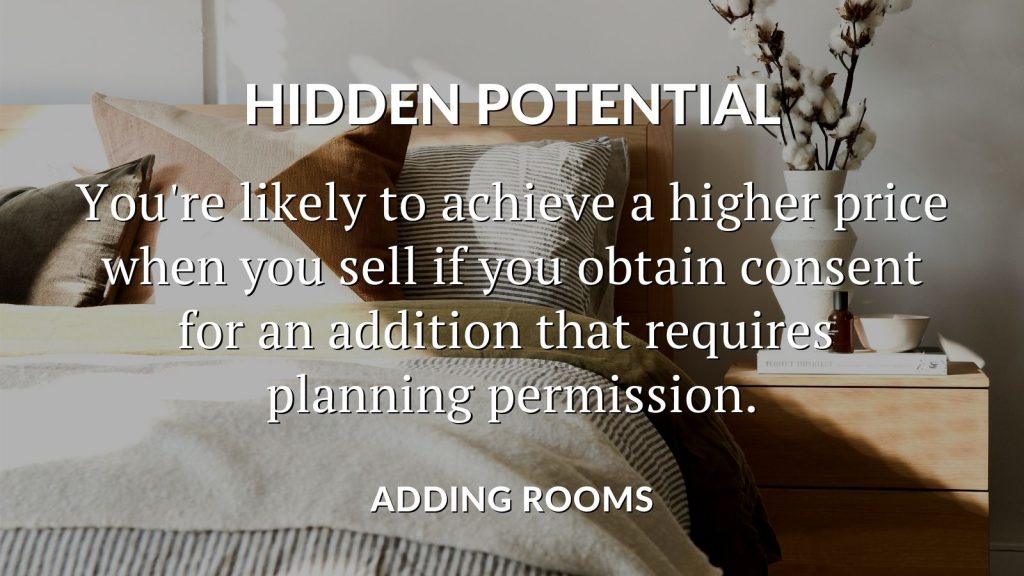
Side extension
A garage attached to a house can often take a floor on top for valuable extra bedroom numbers. Going larger still, an empty space to the side can also provide an additional living room on the ground floor, perhaps for a home office or studio. It may even be possible to create a separate annexe, either for a family member or to rent as an income stream.
Rear extension
The back of a home usually provides the most flexibility in terms of design, and here is where large dining kitchens have become a sought-after feature as a sociable, multi-purpose space opening out to the garden. We also look for the possibility of adding another storey to increase the number of bedrooms.
LOFTS AND CELLARS
Lofts have a special character that suits various uses, particularly with a full staircase installed to make the new top floor an accessible and integrated part of a home.

Having a sumptuous master suite at the top of the house with a private bathroom can provide a welcome sanctuary away from the kids. Or a pair of children’s bedrooms could be made, perhaps with a shared shower room to ease the strain on the main family bathroom.
A loft can also provide the perfect home workspace hidden above the busier areas, or a studio for wellness or creativity.
Down below, the least headline-grabbing feature in older homes is usually the cellar. Generally relegated to junk rooms, they can make an excellent music studio (with adequate soundproofing!), a cinema room (where the darkness is a blessing), or a children’s play den (to keep the living areas clear of toys).
OPENING SPACES
Rooms are used very differently now from the traditional separations of living, dining, cooking and even working.
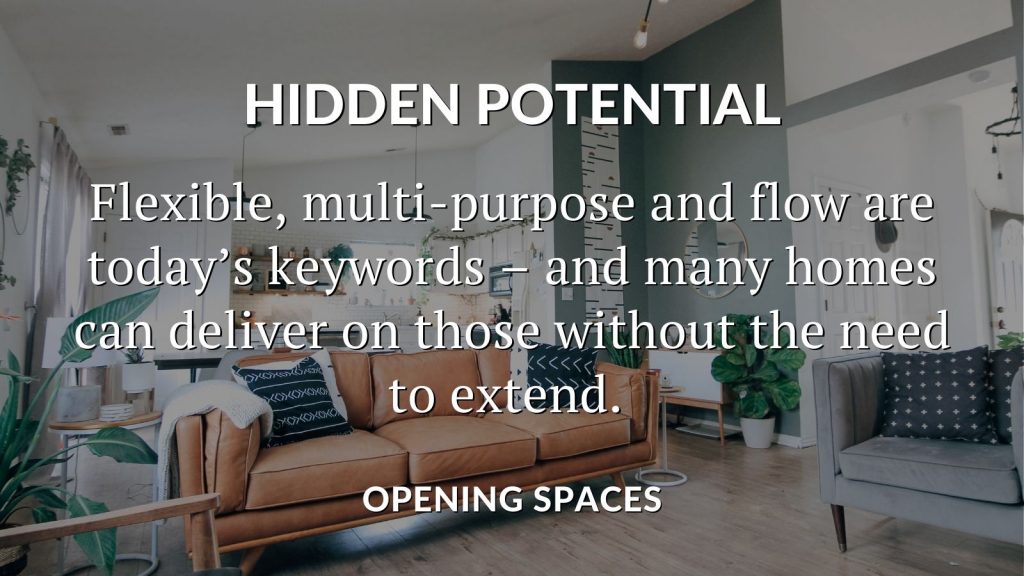
Flexible, multi-purpose and flow are today’s keywords – and many homes can deliver on those without the need to extend. It’s all about finding ways to connect previously separate spaces that can be zoned with furniture rather than physically divided.
Successful and popular designs include:
removing the wall between a hallway and dining room to accept a bigger table and brighten a once-dark corridor;
merging two living rooms in a front-to-back space to suit larger modern couches and TVs;
combining the kitchen and dining room for a flexible and friendly eating, cooking, family and work zone.
LUXURY UPGRADES
Adding extra sizzle is a sure-fire way to stand out from the crowd, while increased comfort gives a home a more enjoyable and desirable quality.

A central cooking island makes a statement and sociable centrepiece in a kitchen that also looks fabulous in photos. Incorporating a utility room keeps the laundry out of the main part of the house. And repurposing an understairs space as a ground floor cloakroom adds value and function, as well as an ideal spot for a glamourous moment.
Enhancing a master bedroom with an en-suite not only injects a seductive slice of indulgence; it also transforms the morning battle for the bathroom and can often be accomplished by repurposing all or part of an adjoining bedroom.
Outside, garden rooms have become more popular than ever. A modern and stylish design makes the perfect home workspace or studio: faster, less intrusive and less costly than extensions or loft conversions.
If overlooking isn’t an issue, a roof terrace above an extension or cut into the roofline can bring an opulent flavour to a bedroom, giving it a private outdoor area with a view – particularly wonderful if a home backs onto open space.
INVITING LIGHT
As a big consideration for buyers, a feeling of airiness and natural light has a hugely positive impact on viewings. Think of it as a daily dose of domestic Vitamin D.
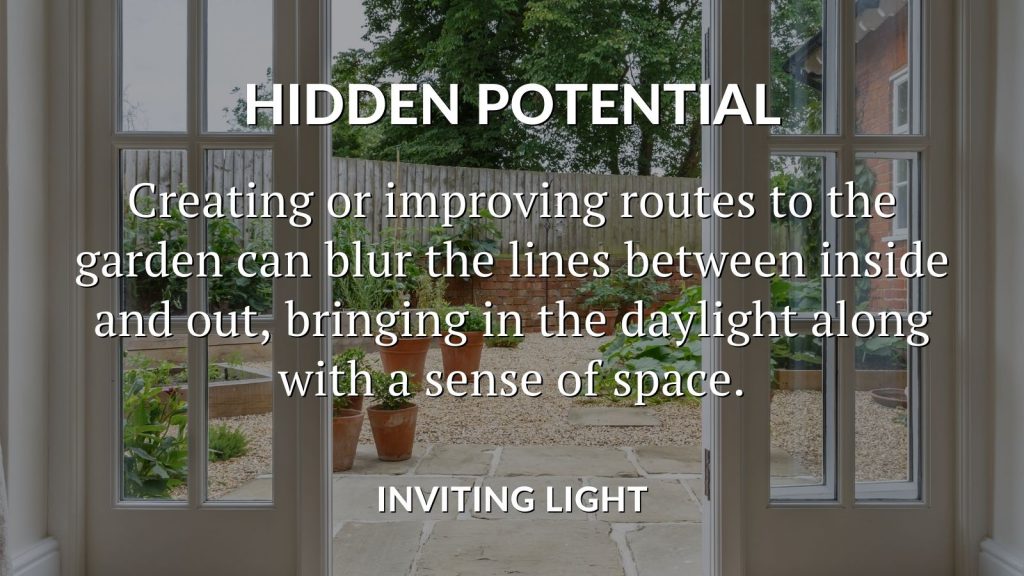
Creating or improving routes to the garden can blur the lines between inside and out, bringing the daylight along with a sense of space. Turning a window into French doors from a living room, or opening up a dining kitchen with a wall of bi-folds onto the patio – bonus points for a skylight overhead – can dramatically increase light levels.
Rear-facing bedrooms take on a whole new persona by having their windows dropped to the floor, with a Juliet balcony adding extra romance and an enhanced view over the garden.
Even dark hallways and landings can be brightened by installing sandblasted glass into solid interior doors, allowing light through without losing privacy.
A final word
Plenty of potential can be realised with straightforward building regulations approval, although we always advise checking with the local authority to see if any proposals require planning permission.
Even when somewhere doesn’t fit a buyer’s exact criteria today, it may have that special something to make it the right choice for their future. And by presenting them with ideas, inspiration and even examples of completed nearby projects, we can help them create the home of their dreams from a property they may have otherwise missed.
To explore the untapped value in your home, call us on 042 933 2482 or email us at info@lavelles.ie– talking about potential is one of our favourite subjects.
SOLD WITH TENANTS: YOUR LANDLORD CHECKLIST FOR BUYING A TENANTED PROPERTY
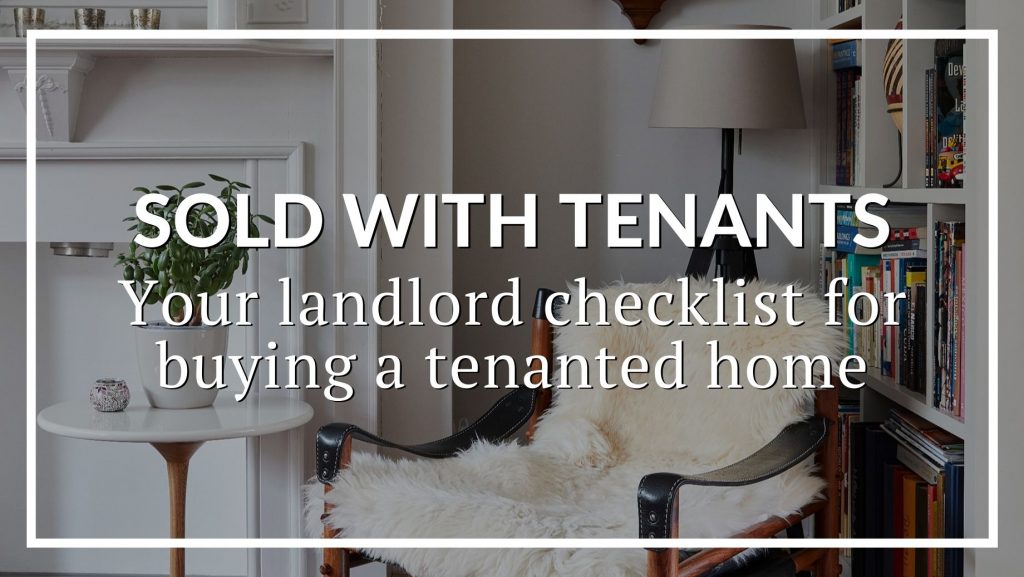
As a fast and chain-free way to start or add to your lettings portfolio, buying a tenanted property can be an attractive proposition.
Usually, when you buy a property to rent out, you’ll need to have it cleaned, fix any repairs, get it on the market, show people around, take up references and create a tenancy agreement before seeing any income. But that’s all taken care of when the property you buy already has a tenant.
However, you’ll also inherit every outstanding responsibility of the previous landlord, and you need to be sure that the property and tenancy are all they seem. Do the figures stack up? Are you happy with the tenant? Will you be taking on unresolved problems or disputes?
Before you make an offer and start incurring legal fees, use our checklist here to ask the right questions and get the story straight. If you’ve already got somewhere in mind and you’re wondering whether it’s a good deal, call us on 042 933 2482 or drop us an email at info@lavelles.ie for a confidential chat – we’ll help you decide if a property is right for you.
RESEARCH FUNDING OPTIONS
Even if you’re considering buying with cash, it’s worth checking to see if your money can perform better elsewhere, particularly with low interest rates for borrowing.

You’ll find plenty of lenders with buy-to-let products, but mortgages for rental homes are not the same as residential loans. They tend to come with additional fees, and some lenders won’t lend on certain types of property, so speak to a financial adviser with experience in the lettings market to find the mortgage that’s right for you and the property.
Lenders typically require the rental income to be at least 125% of the monthly mortgage payments on a buy-to-let loan, and they usually calculate the loan based on the rental value at the time rather than the rent being paid.
You almost certainly won’t get a mortgage on a home with a sitting tenant because lenders see those as far too risky. If you want to borrow for that sort of purchase, you’ll need to remortgage another property.
CRUNCH THE NUMBERS
Doing a bit of homework around the suitability and sustainability of a potential rental investment will help you make a confident and savvy purchase.
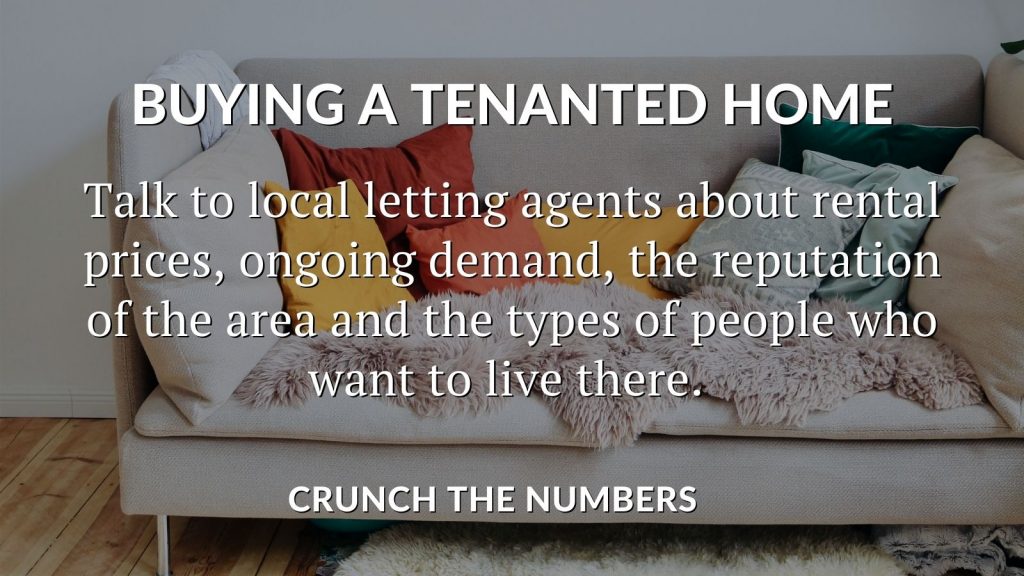
Check current rents and demand
Talk to local letting agents about rental prices, ongoing demand, the reputation of the area and the types of people who want to live there. You need to know that you’re buying in a location where homes are easy to rent, particularly if you’re unfamiliar with the neighbourhood.
See it for yourself
It might sound blindingly obvious, but it’s essential to visit the property you’re buying, even if it’s purely for investment. Mortgage valuations don’t include testing the heating, hot water or appliances, so you need to know whether everything is working correctly or if repairs, replacements and bills are on the horizon.
Walk around the neighbourhood
Spend some time exploring the area to get a good feel for it. Check for yourself how long it takes to get to the supermarket, station, somewhere for coffee, schools and whatever else a tenant would expect from the type of property you are considering.
TALK TO THE TENANTS
There’s nothing like living in a home to know what it’s like, so ask if you can speak with the tenants direct: this could be in person, over the phone or by email. As well as giving you an idea of their character, you’ll learn about their experience of living in the property and whether they plan to stay.
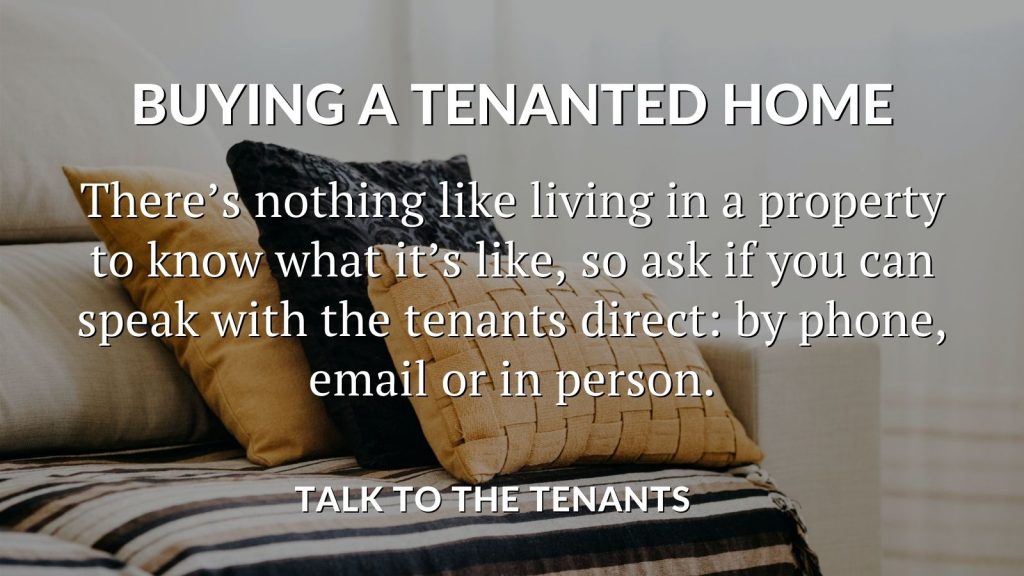
If the tenants are thinking of leaving, find out why. Perhaps they simply need more space, or they’re moving further away, but if it’s down to issues with the property, you might be able to salvage the tenancy by addressing any concerns.
Good tenants are worth holding onto, so it’s worth discussing whether they’d stay if the property was better cared for or more up-to-date. Talk about any repairs or improvements they’d like to see to save losing them unnecessarily. A simple paint job, installing a decent shower, or replacing a dated fridge can make all the difference to someone’s daily life and are benefits your tenants will happily pay extra rent for.
EXPLORE THE HISTORY
As you’ll be taking over a property as the new landlord, you’ll want to know the calibre and performance of the tenants you’re getting.
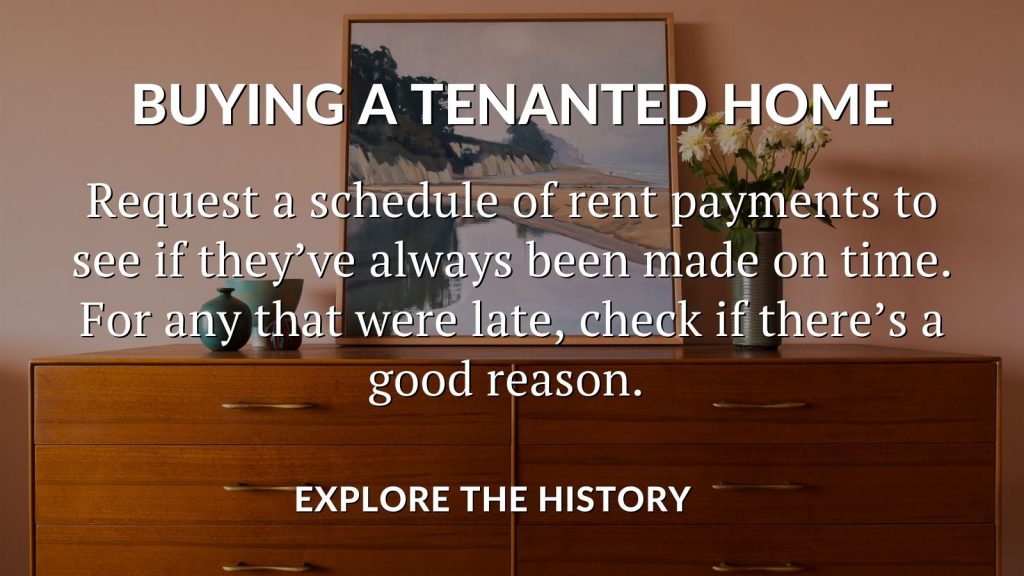
Request a schedule of rent payments to see if they’ve always been on time. For any that were late, check if there’s a good reason. Anyone can hit a bump in the road now and then, but it’s good to know if it’s a one-off or a regular thing.
Ask the current landlord or their managing agent for written details of any maintenance issues during the tenancy and whether all repairs are complete. For any that are still pending, find out whether they’ll be finished before you complete, or if you can negotiate the cost of them off the price you agree.
As a final bit of research, ask if the tenants report problems promptly and politely, and whether they are responsible and reliable renters. Ultimately, is the property in good hands with them living there?
CHECK THE PAPERWORK
While everything will be revealed in the conveyancing process, we recommend getting as much information as possible before instructing a solicitor to proceed.
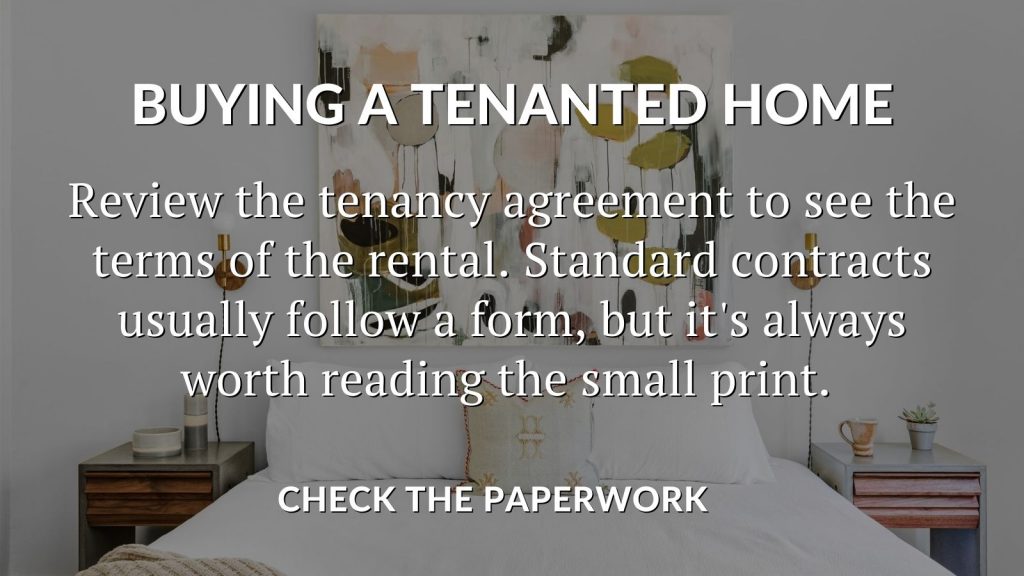
Review the tenancy agreement for the terms of the rental. Standard contracts usually follow a form, but it’s always worth reading the small print. Check that an inventory was created and signed at check-in, and whether a security deposit was taken and where it’s held.
Tenants aren’t obliged to sign new agreements or inventories when the property they live in changes ownership, so it’s important to know how accurate and comprehensive the paperwork is at an early stage.
Finally, ask to see copies of valid gas, electricity and fire safety certificates to ensure that everything is up to date and complies with current regulations. Do the same for any furniture that’s included to see if you need to replace any items.
What’s your next step?
If you’re thinking about buying a tenanted property in County Louth, or you’ve recently bought one and you’re looking for a managing agent, why not get in touch? Speak to our friendly team of experts on 042 933 2482 or email us at info@lavelles.ie– we’re here to help you make the most of being a landlord.
BACK ON THE MARKET: CAN CHANGING YOUR ESTATE AGENT RESTART YOUR MOVE?

Nobody wants to feel left on the shelf. Seeing your neighbours sell and move out while you’re stuck on the market for months, can be disheartening and confusing. And when you’ve poured your heart and soul into your home, but nobody seems to want it, what are you supposed to do? How long is too long before you give up?
It might be small comfort, but many homes fail to sell with their first agent, so you’re neither alone nor even unusual. Perhaps the initial momentum has stalled, or there was never one in the first place. Maybe the advice you received hasn’t delivered the promised results, or a price reduction hasn’t worked, or the contact from your agent has been a source of disappointment.
Wherever you’re at right now, the idea of switching estate agents might seem like a bit of a hassle with no guarantee of success, but for many people, it was the pivotal moment in getting their move back on track.
If you’re unsure what to do next, call us on 042 933 2482 or email us at info@lavelles.ie
for a confidential chat about your plans. Meanwhile, let’s look at how you can start again without going back to square one.
FACT-FINDING TIME
First things first: have an honest, straightforward and detailed chat with your current agent.
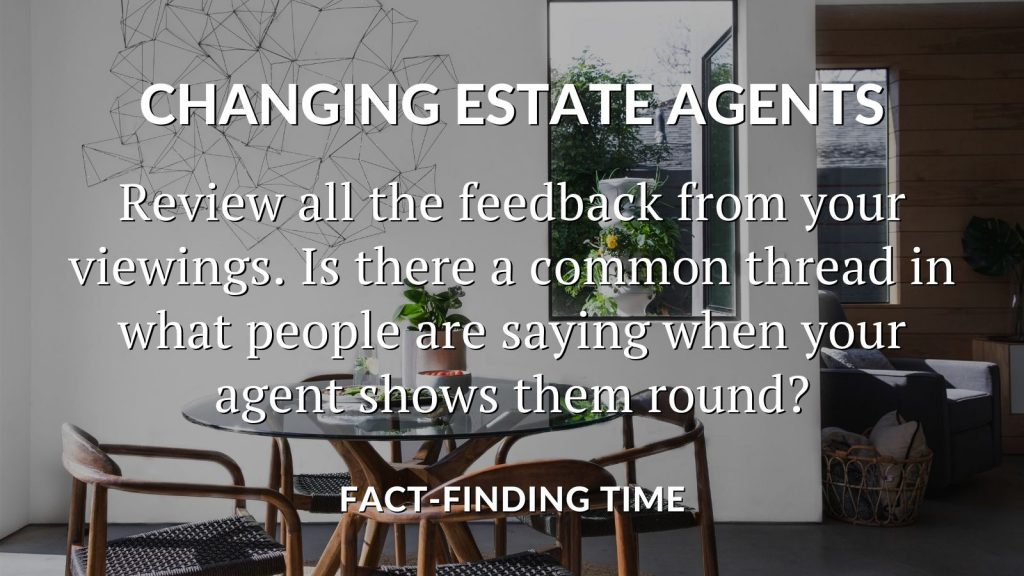
Request details on the number of enquiries from when you began so you can see whether interest has been consistent, intermittent and where it dropped. You could even call your agent and pose as a buyer to discover how they talk about your home.
Next, review all the feedback from your viewings. Look for clues in the responses around location, interior layout & room sizes, distance from schools or transport, garden privacy, and general presentation or style. Is there a common thread in what people are saying when your agent shows them round?
Finally, are you happy with the marketing of your home and the service you receive? Do the description and photographs compel someone to view, and does your agent stay in touch and offer constructive advice? Ask about homes they’ve sold that are similar to yours and why they were more successful.
TAKING STOCK
With all the information you’ve gathered, you should now have a clear picture of why your home isn’t selling. That means it’s decision time.
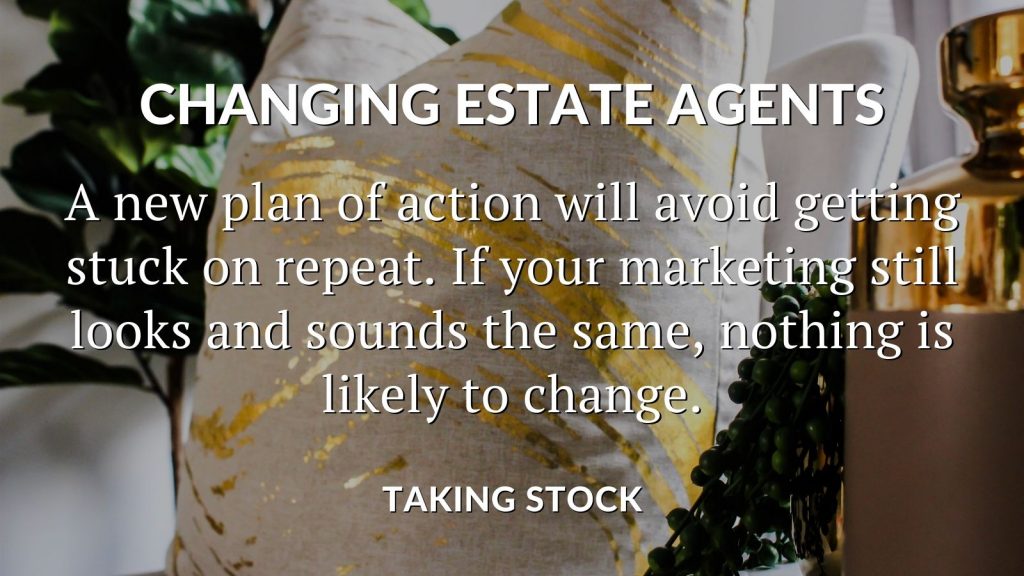
Do you feel the reasons why your home hasn’t sold are nothing to do with your agent? To continue working with them, you need a new plan of action to avoid getting stuck on repeat. If the marketing for your home still looks and sounds the same, nothing is likely to change.
For a completely fresh start with a new agency, check your current agreement first for any tie-in or notice periods to ensure you don’t become liable for two sets of fees.
Depending on the number of months your agent has already had and how long since their last enquiry or viewing, you might be able to negotiate a shorter time to part company. It’s always worth asking the question.
EXPLORING ALTERNATIVES
If you already have a second choice from when you first put your home up for sale, ask them if their initial advice still stands with the feedback you have from your viewings.
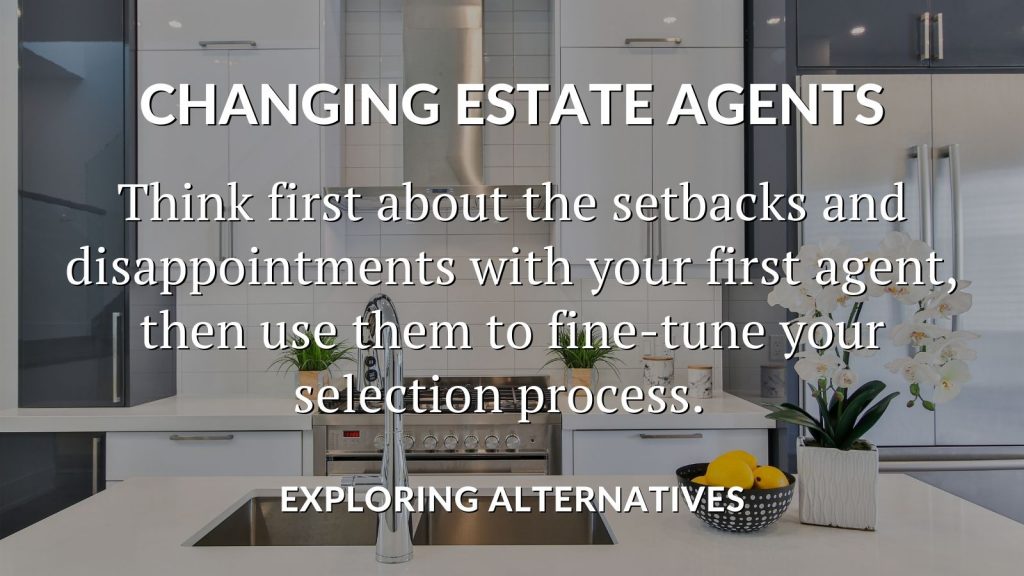
To hear some new opinions and ideas, think first about the setbacks and disappointments with your first agent, then use them to fine-tune your selection process.
Look at how agents present and describe their homes online, and note down the ones you feel most drawn to. Then check their reviews on Google or Facebook for an impression of how customers rate their experience.
With your shortlist, carry out one final test before inviting anyone round. Call each agent about a home they’re marketing to gauge their enthusiasm and knowledge, along with how much interest they take in you as a potential buyer. Do they check whether your requirements match the property, that you’re in a position to move, and then invite you to view?
Ask yourself how inspired you feel after speaking to each one.
INVITE, INTERVIEW & INSTRUCT
Now it’s time to meet the candidates in person.

Hopefully, they’ll ask you all sorts of things about your home. To help them factor everything into their suggested asking price and strategy, tell them as much as you can and talk about your previous experience and feedback.
When it comes to each valuation, is it supported by other nearby sales? If it sounds high, even delightfully so, is it credible? A home with unique qualities can achieve more than established local prices, but flattery alone will not get you sold. Watch for any advice that sounds good but doesn’t stack up, then feel free to challenge it: setting your price is very much a two-way discussion.
Your research revealed how agents present their homes, but what’s their plan to generate interest, maintain momentum, and find you a buyer? It’s also worth checking how they’ll keep you up-to-date: nine times out of ten, communication is the biggest let-down that people tell us about – even more than their home not selling.
As well as all this nitty-gritty, think about how it feels when talking to each agent. You’ll be working together for months, so you need to feel cared for as well as confident to be comfortable with your choice.
RELAUNCH FOR SUCCESS
You’ve found an agent who’s just right – now it’s time to agree on a date for your return to the marketplace. Perhaps you’d like a week or two to recharge your batteries after tidying up every day for months, or you might want to finesse the presentation of your home.

To optimise your new marketing drive, use the feedback from your previous viewers to make your next ones a success: those remarks can be priceless in getting it right second time around. Focus on any repairs, tidying, rearranging – or cleaning! – that will have your home looking irresistible in photographs, as well as in person.
With the benefit of hindsight on your side, work together with your new agent to help them avoid previous mistakes and missteps. Let them know if your home was incorrectly described, if any rooms photograph better from a different angle, or if any crucial details were missed.
Could we do better?
If you’ve been struggling to sell your property in County Louth, perhaps a fresh approach and a change of agents can turn your move around. So instead of giving up hope, why not get in touch?
Call us on 042 933 2482 or drop us an email at info@lavelles.ie– you could be one step away from finding your perfect buyer and successfully moving home.
ACCIDENTAL LANDLORD? ALL YOU NEED TO KNOW TO MAKE IT A SUCCESS
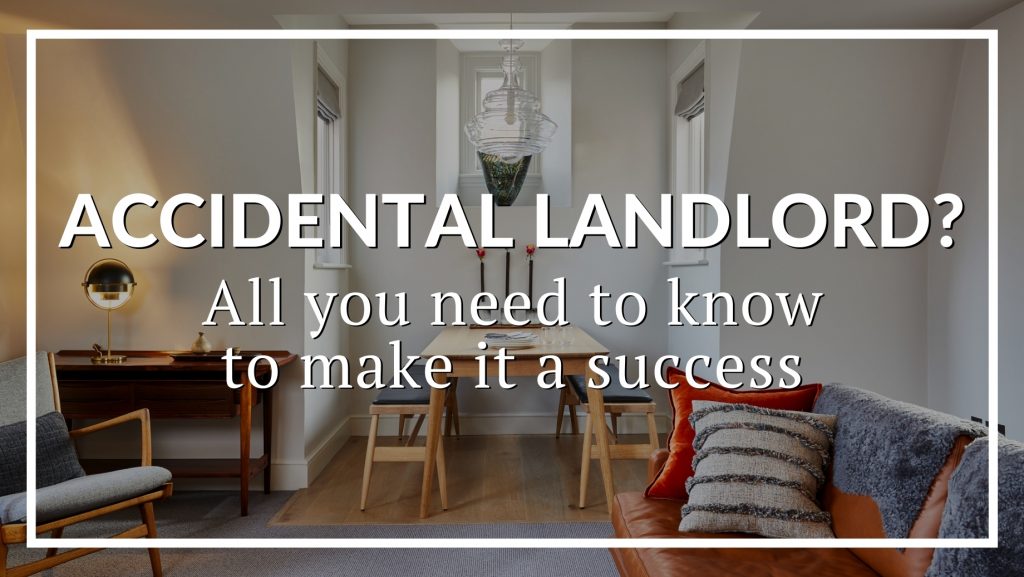
Not everyone sets out to be a landlord, and becoming an accidental one is more common than you might think.
An accidental landlord is someone who becomes a landlord by circumstance rather than by plan, and it can happen for several reasons. You could be relocating for work, moving in with your partner, or having trouble finding a buyer for your current home. Or you might have inherited a property.
Being a landlord can provide you with an unexpected passive income stream, but there’s a lot to know before you get started. Lettings legislation is complex, forever changing and comes with plenty of responsibility, so it pays to be informed to make your transition from property owner to landlord as smooth as possible.
We’re here to help you get started, so call us on 042 933 2482, drop us an email at info@lavelles.ie, or simply read on for an introduction to becoming an accidental landlord.
FINDING & MANAGING TENANTS
Generally speaking, landlords divide into two camps: those who choose to self-manage once a letting agent has found them a tenant, and those who ask a managing agent to take care of everything.
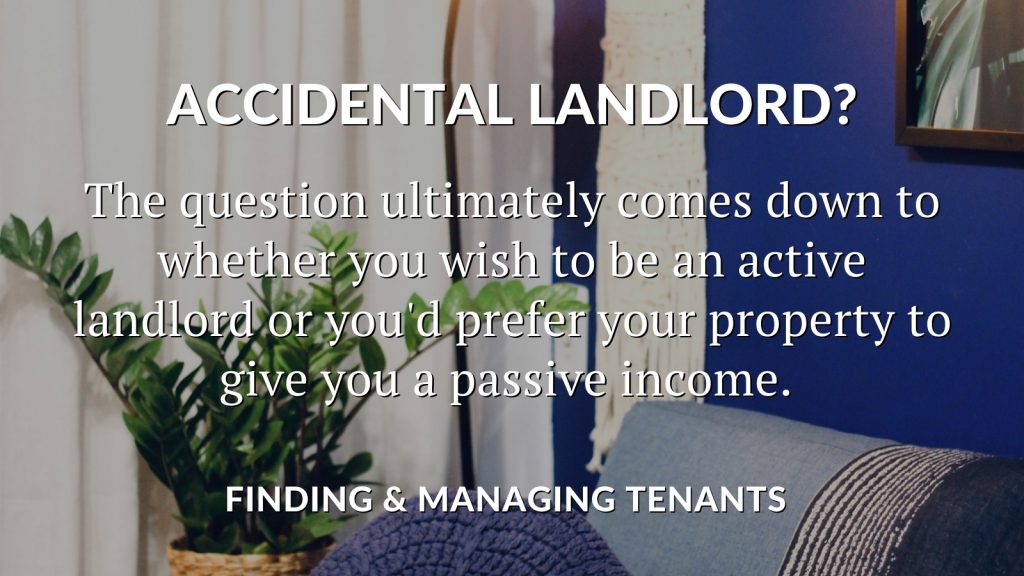
The question ultimately comes down to whether you wish to be an active landlord, or one with a passive income. To help you decide which option is right for you, here’s a quick rundown of what’s involved.
Finding a tenant entails advertising your property, vetting enquiries for their suitability, attending viewings, negotiating offers and referencing prospective candidates. Creating a tenancy means getting your property professionally cleaned, preparing a tenancy agreement, collecting the first month’s rent and security deposit, drawing up a detailed inventory and then meeting the tenants to sign off on the paperwork and hand over the keys.
Ongoing management includes: organising gas and electrical safety checks; dealing with maintenance, repairs and emergencies; carrying out inspections during the tenancy; staying on top of lettings legislation; ensuring payment of rent; handling any issues that may arise with your tenants or their neighbours; meeting the tenants to collect the keys when they move out, and finally checking your property against the inventory to agree on any deductions from the security deposit.
If you live near your rental property and have the time and inclination to deal with all of the above, being a self-managing landlord could be for you. If you live further away, or you’re busy enough already, it could prove impractical to manage everything yourself.
PREPARING YOUR PROPERTY
As a legal requirement, you’ll need to comply with gas, electricity, and fire safety regulations by obtaining certificates and installing smoke alarms. But a successful rental property is also one that’s easy and enjoyable to live in.
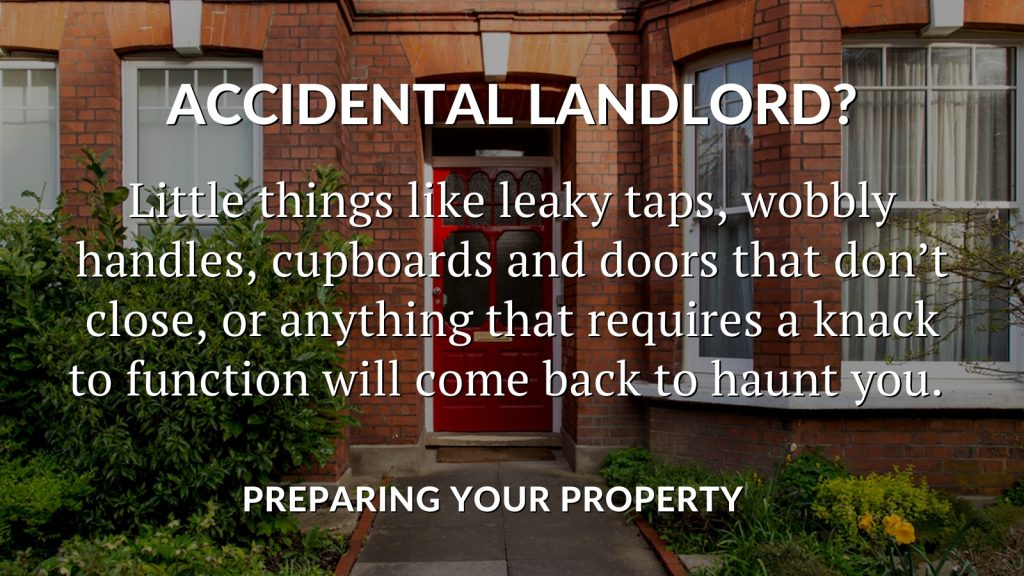
If you’ve lived in your home for a long time, you’re probably used to its quirks, and you might not have remedied minor repairs. We’re all busy, and it’s easy to forget non-urgent tasks with a thousand other things to do.
For an inherited property, you may need to bring it up-to-date with modern standards and expectations. And if you’ve never lived there, you’re less likely to be fully aware of ongoing problems, overdue maintenance or outstanding repairs.
When a tenant moves in, they’ll experience all that’s good and all that’s bad in a very short space of time. This might prove overwhelming and upsetting for them while giving you a long and urgent to-do list.
Little things like leaky taps, wobbly handles, cupboards and doors that don’t close, or anything that requires a knack to function will almost certainly come back to haunt you. Fix them now to avoid them becoming a source of unnecessary friction.
For larger expenses like upgrading fittings and appliances, talk to us first. We’ll help you budget correctly and optimise your rental income by creating exactly the sort of home that tenants want to rent.
MORTGAGES AND TAX
Lending policies vary widely.
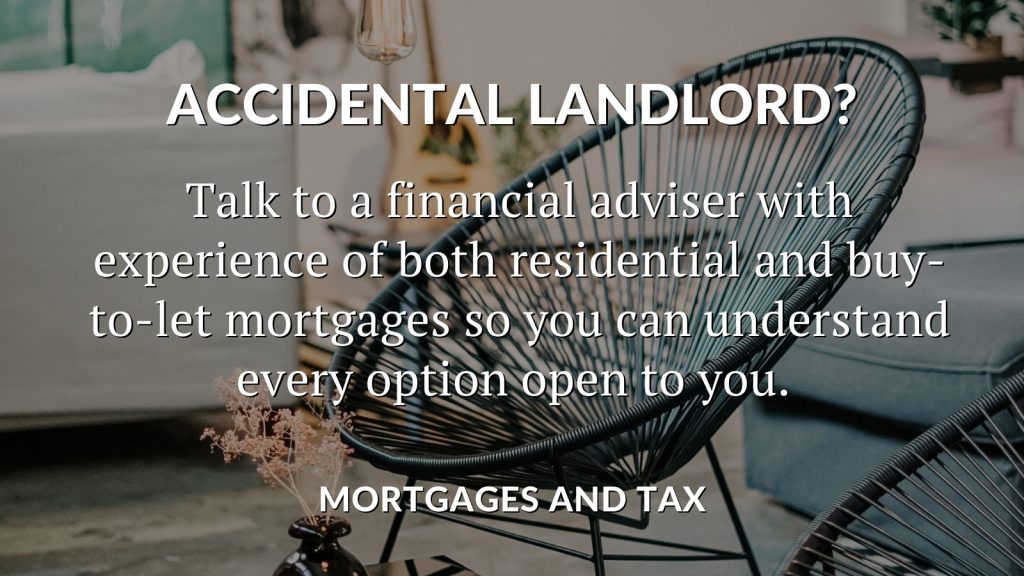
If you have a mortgage on your existing home, you’ll need to inform your lender that you intend to rent it out. Depending on the terms and conditions of your loan, you may be allowed to stay on the same arrangement, or they may switch you to a more expensive buy-to-let rate.
Before you commit to anything, explore other lenders to see whether you can remortgage with them on more flexible terms.
Talk to a financial adviser with experience in residential and buy-to-let mortgages to understand every option open to you. Rates and products are changing all the time, and you may even find a more competitive deal than your current one.
The rent you receive from your property is taxable, but there are various costs you can claim back. In general, maintenance, repairs and management are allowable expenses, but improvements are not.
As an example: if the oven breaks down and you need to replace it, you can take the cost off your income, but if you decide to upgrade the kitchen, that’s not an allowable expense. That said, you’ll undoubtedly increase the rent you achieve by keeping your property up to scratch and ahead of the competition.
INSURANCE & INVENTORIES
Most rentals are unfurnished. That’s partly down to the strict rules around fire safety and furniture, and also because tenancies are getting longer: tenants want to be surrounded by their own belongings to feel completely at home.
Yet even an unfurnished property has plenty inside that needs to be insured: kitchen cupboards & appliances; bathroom fittings; a heating system; floor coverings; electrical sockets & switches; maybe some light fittings, curtains or blinds. So, alongside your regular Building Insurance policy, you should take out Landlord Contents Insurance to provide you with sufficient cover in the event of damage.
An inventory is another essential component and can protect you and your tenants from unnecessary misunderstandings. The lack of one is why many landlords lose deposit disputes, because they need to prove loss or neglect to make a valid claim.
Preparing an inventory yourself can leave you vulnerable to dispute as it might be seen as subjective. You’re much better off instructing an experienced and independent third party to provide a comprehensive written and photographic account of your property’s fittings and condition.
STAYING WITHIN THE LAW
Depending on your mindset, landlord legislation is either a fascinating and forever-changing landscape that thrills at every turn, or a minefield of obstacles and paperwork that sends you running for the hills.
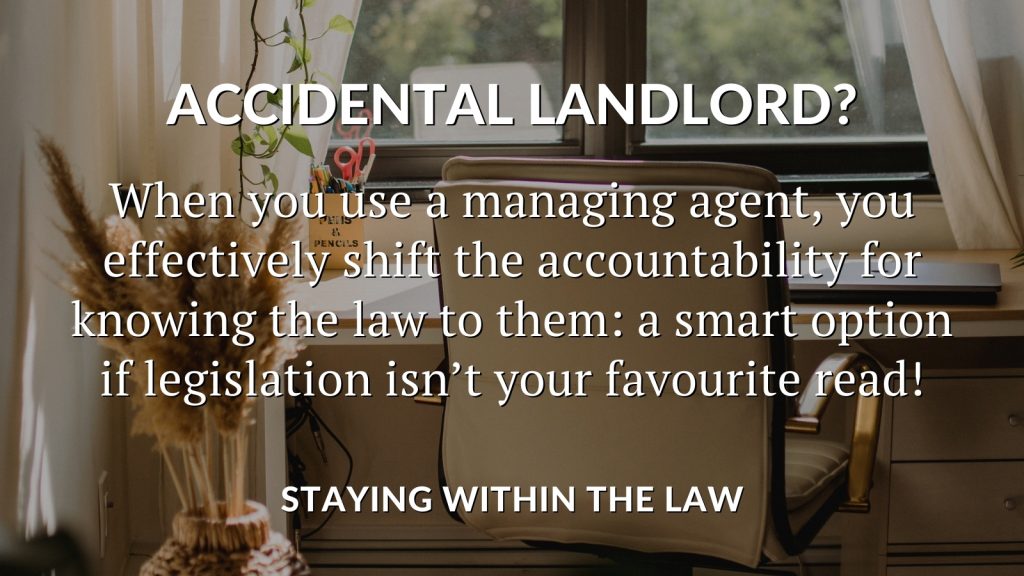
Whatever your view, it’s your responsibility as a landlord to ensure that your property complies with all current regulations around gas, electrical and fire safety, as well as habitation. It’s a non-negotiable requirement, and ignorance is not a defence. Fines can be heavy, so don’t leave anything to chance.
If you intend to be a self-managing landlord, the best way to stay fully informed about your responsibilities is either through online landlord forums or by regularly checking the government’s website for updates to the law. When you use a managing agent, you effectively shift the accountability for knowing the law to them: an attractive option when legislation isn’t your favourite read!
In summary
Becoming an accidental landlord can provide you with an income-producing asset for many years and into retirement. By preparing your home correctly, staying on top of maintenance, attending swiftly to repairs, and keeping abreast of legislation, you’ll lay the groundwork for a run of successful tenancies.
Do you have any questions about renting out your existing home or an inherited property in County Louth? We’ve helped many people step into landlord life with minimal fuss and who now enjoy an extra income stream with many positive impacts on their lifestyle.
We’d love to do the same for you, so call us on 042 933 2482 or email us at info@lavelles.ie. With our expert guidance and professional hand-holding, you can start life as a landlord with confidence.
SETTING THE SCENE: HOW TO BE READY FOR VIEWINGS EVERY DAY
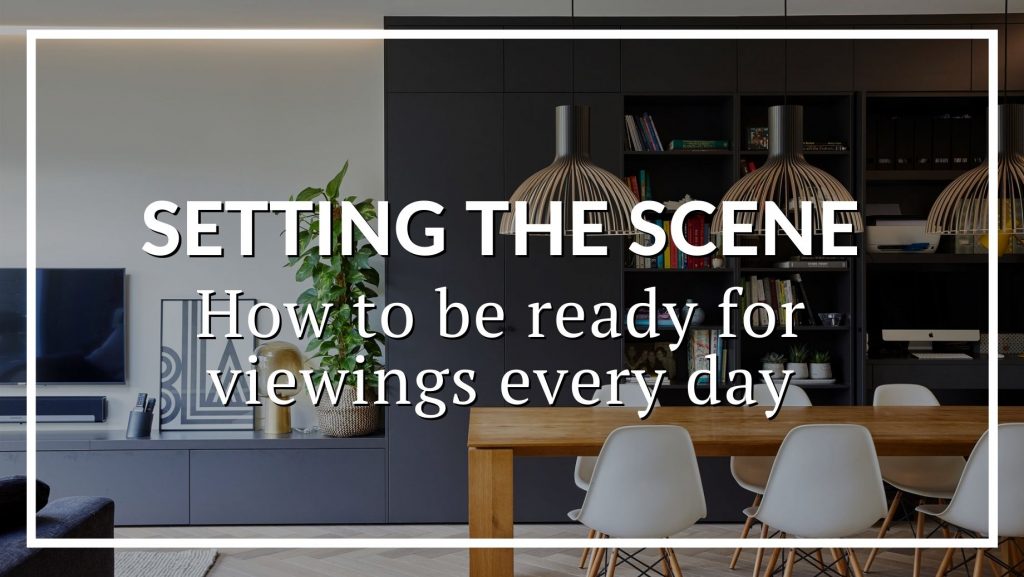
No matter how neat and tidy they are, people always ask us how their home should look on viewings and whether they can improve their presentation.
While no one expects you to live in a perfect show home, buyers do react well to a bit of pizzazz and polish. They’re looking to be seduced, and the way you present your home can shorten the time it takes to agree a sale, which means less tidying up in the long run.
Viewings can happen any day, and the trick is to minimise disruption to your morning routine so you can get ready for work, prepare the kids for school or go for your daily run without adding a lengthy to-do list. Then you can leave the house knowing that everything looks just right, without feeling flustered or rushed – or at least no more than usual!
With a simple plan and some upfront preparation, it’s fairly straightforward to be ready for viewings every day without feeling as though you’re living in a museum. A home that’s full of love and full of life is a big selling point for buyers, so this week’s blog is about finding the perfect balance between maintaining your happy home life and presenting a home that sells.
BEFORE YOUR HOME IS FOR SALE
Now is when you’ll be energised with the excitement of moving and putting your home on the market, so let’s make the most of your enthusiasm.
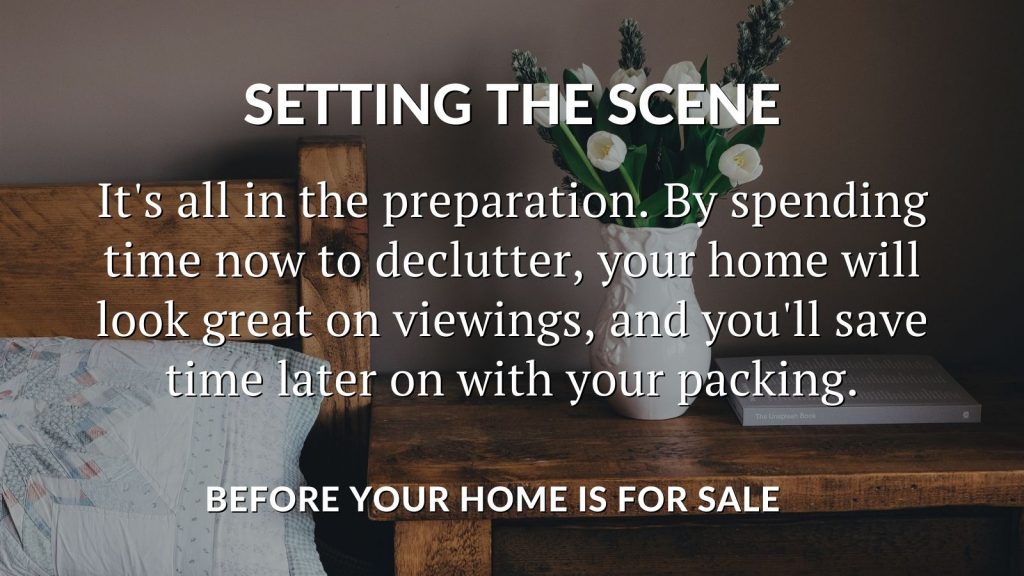
When it comes to having your home photographed, you can often get away with hiding things around a corner to get the perfect shot. But to prepare for viewings, you need a more permanent solution.
We’ll happily give you some pointers on getting your rooms looking right. Then, we’d suggest a weekend purge to deal with any visible or hidden clutter. Make it a household event with Spotify playlists, pizza deliveries, coffee on constant rotation… whatever makes it fun for you.
With storage space a priority for buyers, they’ll pay attention to your cupboards. If they’re full to the brim, tackle them now rather than waiting until you pack – you’ll save time later, and your home won’t feel like it’s bursting at the seams.
Once you’ve chosen what to sell, donate, store or throw away, make your listings live on eBay, head down to the charity shop with any donations, and get everything else bagged up and boxed before the caffeine wears off.
Still got too much stuff? Try spreading it out across the loft, cellar or garage. Alternatively, ask a willing friend or relative to keep some at theirs, or rent a storeroom until you move.
CLEANING & LAUNDRY
Just like death and taxes, laundry is a fact of life, but sheets hung over doors are never a good look.
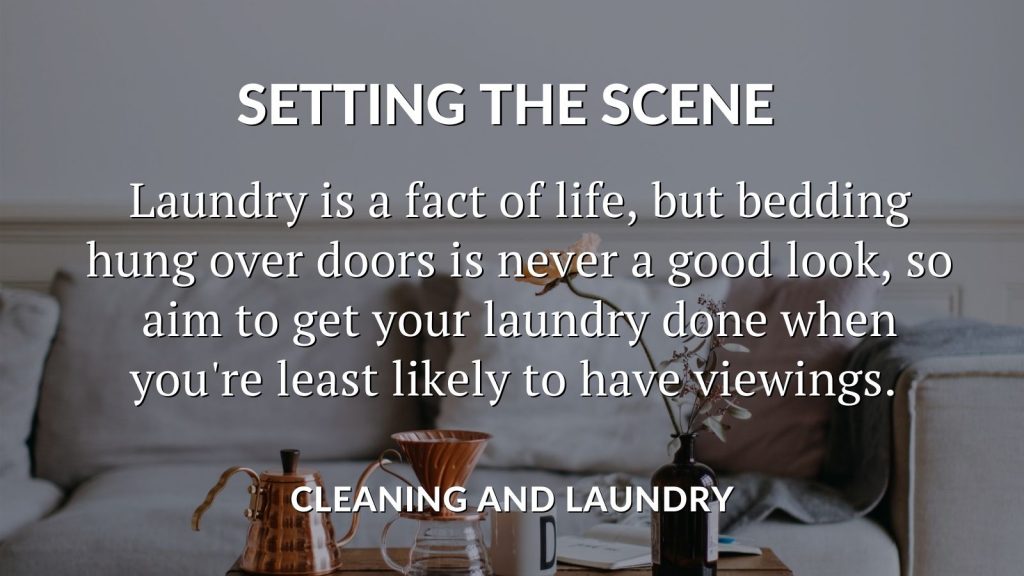
Aim to get your laundry done when you’re least likely to have viewings. That might be a Saturday evening, so it’s dry, folded and put away by Sunday night, leaving you clear for the rest of the week.
Do you have a cleaner? Tell us their schedule to help us time your viewings accordingly. As a tip, we’re often in the office on Monday mornings to follow up on the weekend’s viewings, gather feedback and deal with offers, so this can be the perfect time for your cleaner to work their magic.
With longer days and the approach of summer, most viewings will happen when it’s light, and the natural brightness of your rooms will become immediately clear. The rays of the sun highlight how clean your windows are, so make sure they’re kept sparkling and see-through, either by you or by a pro.
SCENTS & SENSIBILITY
From beginning to end, the scent of your home is the backdrop to every viewing. As the sense most connected to memory, smell does more than create an instant impression; it leaves a lasting reminder. What better excuse for some aroma therapy?

If we all lived in the pages of a magazine, freshly-cut flowers and gently roasted coffee beans would appear every day, imbuing your home with fragrant greetings. Real-life isn’t necessarily like that, but that doesn’t mean you’re out of options.
First off, never underestimate the power of nature. The simple act of leaving a couple of windows securely ajar will keep the inside air circulating and noticeably refreshed.
For something more aromatic, try a couple of well-placed reed diffusers or scented candles. Go for high-quality, natural fragrances and don’t go overboard; too many can be overwhelming and even raise suspicions, so buy one or two and gauge the effects. You can always add more later.
Flavoursome aromas like coffee and nutmeg are foodie favourites for kitchens; calming lavender or vanilla create a soothing mood for bedrooms, and crisp scents like lemongrass or ginger keep bathrooms feeling fresh.
If you love curries, garlic, fish or other pungent foods, save cooking those meals for a Saturday night to give the air in your home a chance to clear.
BEFORE BEDTIME
Evenings are your best friend when it comes to tidying up.
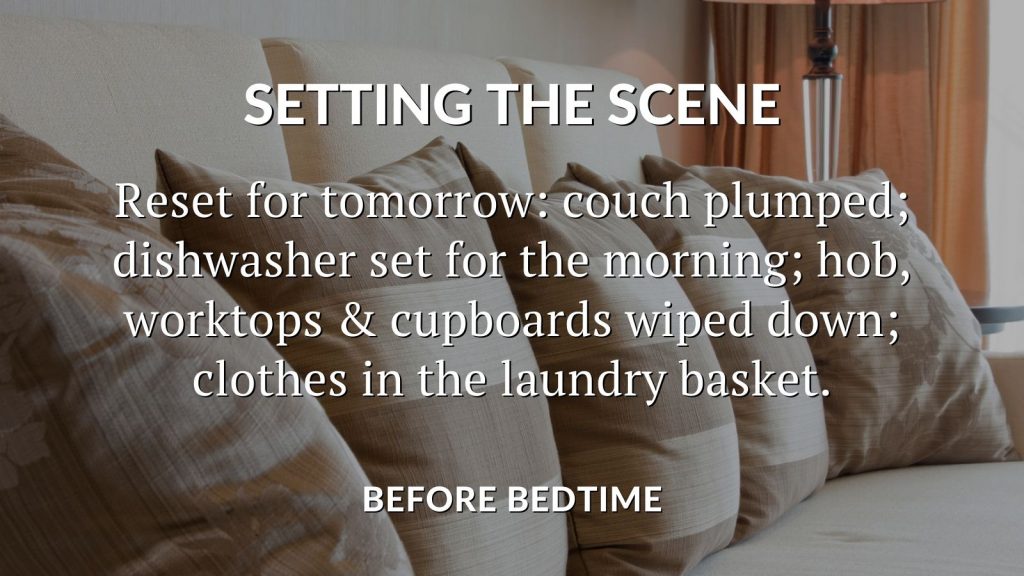
As well as shaving valuable minutes and fuss off your morning routine, performing a reset for tomorrow brings a natural end to the day. You’ll probably even sleep better knowing how well you’ve got everything handled.
- Put the living room back together by plumping up cushions, neatening throws, and returning books, magazines and paperwork to where they belong.
- Do the washing up, put it away, or get everything into the dishwasher and set for the morning. Check bins and empty them if necessary.
- Wipe down hob, worktops and cupboard fronts to remove any cooking prep and spills.
- Get any toys into crates, then either hide them away – under the bed, in a cupboard, on top of the wardrobe – or put them in a corner to keep the floor space clear.
- Drop clothes into the laundry basket or hang them inside the wardrobe.
THE TEN-MINUTE TIDY
With everything else in place, the final finishing touches are all that’s left for the morning. Do a quick sweep with this speedy checklist for an easy and on-time start to your day.
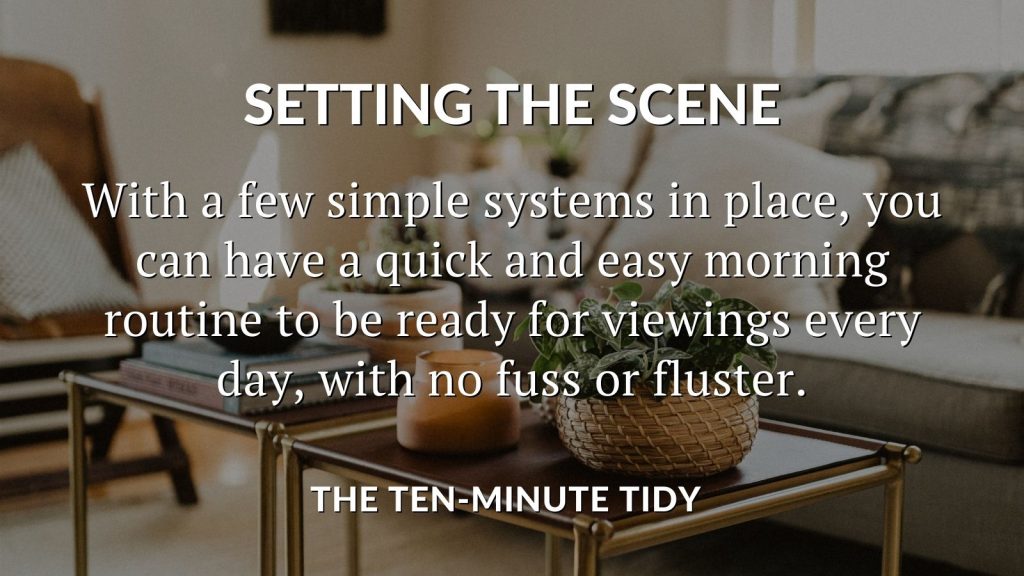
DOORS & WINDOWS
Leave all internal doors open for air circulation and a sense of flow
Open curtains and blinds for maximum light
KITCHEN
Breakfast plates, coffee cups and pans in the dishwasher, or rinsed and put away
Tea towel hung in its place
Wipe down worktops and sink
BEDROOMS
Make the bed and plump the pillows
Close wardrobe doors and drawers
Put away any jewellery and accessories
BATHROOMS
Shower screen squeegeed
Toothbrushes and toothpaste away
Posh products only left on show
Towels on hooks or folded on rails
Feng shui etiquette – loo seat down
In summary
Preparation is everything. Spending some time before your home goes on the market to get everything in order, then having some simple routines to keep it that way, will help you enjoy your everyday home life while being ready for viewings, no matter how much notice you have.
Most tasks are tiny in themselves but combine to make a big and lasting impression, as though you’ve had a cleaner in every day.
Are you planning to sell your home? We’re here to ensure you make the biggest impact, so why not get in touch? Call us on 042 933 2482 or email us at info@lavelles.ie– we’ll help you get your presentation perfect from the start.
LETTING AGENTS: HOW TO PICK THE BEST ONE

Whether you’ve been a landlord for years or you’re just starting out, finding a letting agent you can trust and build a long-lasting relationship with is a big deal.
Renting out your property is about so much more than just money and business. As well as wanting an agent who can find you the perfect tenant, you’re sure to have feelings around confidence, connection and communication. None of these are financial concerns, but our experience tells us how prized they are by all of our landlord clients.
Letting agents will be competing for your business left, right, and centre, so how do you begin the selection process? Having a list of standards is a good place to start, and these five factors will help you narrow down the field and choose the best letting agent for you.
LOCATION, LOCATION, LOCATION
It might sound really obvious, but choosing an agent close to your rental property makes sound business sense.

Letting agents who live and breathe an area are the best equipped to rent your property quickly, and for many reasons:
- they’ll always be nearby for viewings, which for lettings can be last minute.
- they’ll have a list of potential tenants looking for a property just like yours.
- they’ll know exactly what rents are achievable to keep your income flowing.
- they’ll know all about transport links as well as the best places to eat, drink & shop.
- they’ll have a pool of local contractors who can help with presentation and repairs.
Ask about the size of the area your agent covers. Are they truly local experts, or are they spreading themselves too thin? Nobody can be in two places at once, and a random smattering of properties that are a long way from each other could mean travelling long distances between appointments. This cuts down on the number of viewings an agent can attend and dilutes their local expertise and profile.
PRETEND TO BE A TENANT
There’s no better way of finding out what a company is really like than by posing as a customer. As a landlord and possible client, letting agents will be going all-out to impress you, but you also need to know how they talk to potential tenants.

Take a look at an agent’s website and find a property to enquire about, then prepare a few questions that aren’t covered in the description to test their knowledge and customer service. You’re not looking to be awkward or to catch them out; you’re simply doing some fact-finding around the experience of dealing with them. If you don’t feel comfortable making the call yourself, ask a friend to do it for you.
Your questions should be easy to answer without someone needing to call you back. Try asking what parking is like on the street, how much passing traffic there is, or how noisy the neighbourhood is at night. You can’t find those answers on Google maps, and a good letting agent will know their stuff.
Look for how long it takes the agent to answer the phone, then for how polite, professional and interested they are. Do they have an obvious knowledge of the property you’ve enquired about? Do they invite you to view or ask about the type of home you’re looking to rent? And how does your experience leave you feeling – like you’ve made a new friend, or like an interruption to someone’s day?
PROMOTION & PERFORMANCE
To be sure of reaching the best selection of tenants, your property needs to be on at least one of the national portals, so ask about an agent’s choice of channel and why they made that decision. Agents have varying results with different portals, so one isn’t necessarily right over another. What matters most is that whichever portal your agent has chosen will get you the right result.

Now take a look at how they describe the homes they rent. Are their descriptions enthusiastic and informative? Lettings can be fast-moving, so they don’t need to be War & Peace – or even Harry Potter & The Sorcerer’s Stone – but they should at least be clear and helpful, and they should make you want to view.
Finally, ask your agent about their results. What’s the average time it takes them to find a tenant? Do homes like yours rent quicker or faster than others? Can they show you examples of successful recent lettings?
Be wary of false promises. Look for answers that are believable and realistic.
COMMUNICATION & CARE
Something we often hear from our landlords is how much they feel they matter to us. You can’t put a price on sentiment like that, and you deserve the same.

When you’re speaking to agents, ask for details of their service standards to ensure that whatever they are offering is compatible with what you need.
What’s their system for giving you feedback after viewings? Not every property goes in its first week on the market, and you’ll want constructive advice and unfiltered commentary to know what action to take.
Will you have a specific point of contact for when you want to get in touch? Ask them how and when they’ll keep you up-to-date.
Happy landlords are our number one priority, and we make sure they feel valued and remembered.
TRUST YOUR INSTINCTS
Every letting agent you meet could say all the right things and impress you with their knowledge and results, so which one do you choose?

We could list countless more points and essential tips on what to look for in a letting agent, but one thing you should never overlook is how it feels when you’re talking to them.
Using a letting agent is a long-term relationship. As well as finding one who measures up to everything we’ve set out here, you should enjoy speaking to the person who’ll be looking after you and your investment—someone who gives you the comforting sense that you’re in safe hands.
Of course, we hope you find that in us. The best way to feel completely comfortable is to get every question and concern answered, so ask us anything you want to feel 100% sure.
In summary
Choosing the best letting agent for you combines practical concerns around a company’s location, customer service and results, along with the personal qualities of the agent you meet and talk to. Ultimately you want to feel that you’ve added a valuable addition to your buy-to-let business.
If you’re a landlord and you’re looking for a letting agent in County Louth, we’d love to have a chat about working with you. Alternatively, you could secret shop us first and test us on one of our homes! We’re sure we’ll pass with distinction, so call us on 042 933 2482 or send us an email at info@lavelles.ie to experience our service first-hand.
THE PERFECT BUYER: HOW DO WE FIND YOURS?

Being an estate agent is a bit like running a dating agency: playing Cupid every day, cultivating commitment and building long-term relationships that lead to living together. It’s more than marketing; it’s matchmaking!
If you’ve ever experienced online dating, you’ll know that someone’s profile and pictures never tell the full story: it’s only when you meet that you know if it’s going to work. Until then, you’ve only got their looks to go on.
That’s just what it’s like when selling your home. The property portals are effectively Tinder for buyers and, with so many listings on show, it can sometimes come down to chance whether someone stops on your profile or simply scrolls on by.
Marketing is an essential first step, but there’s more than that to estate agency; it’s about listening to people’s stories, forming connections and building trust. It all comes down to crafting those magical a-ha moments of: “we’ve got just the person”, and here’s where we show you how.
KNOWING YOUR STORY
Right now, your thoughts are probably looking forward to everything you’re hoping for in your next home: the extra space, a bigger garden, maybe somewhere for an office or studio. The future is really exciting, and that’s where your focus goes.

But to find you the perfect buyer, we need to go back in time to when you bought your current home. Very often, people coming to view will be at the same stage in life as when you first moved in, so it’s helpful to know why you chose this home out of all the others available.
What did you think when you first arrived outside? How did you feel when you stepped into the hallway? When did the moment hit that this was ‘the one’ for you?
When we tell potential buyers why you fell in love with your home, it adds another dimension to viewings beyond the bricks and mortar. Whether it’s how the morning light hits the dining table, or your favourite sunspot in the garden, or where you love to curl up with a good book, it all paints a picture.
Even if your home looks perfect today, are there any ideas you’ve had for making it even better? Hidden possibility and further potential can ignite valuable extra interest, so don’t be afraid to tell all!
TIMING IS EVERYTHING
Not everyone is looking to move at the same speed, and matching people’s timescales is a vital component in getting any sale to work, so it helps to know the dates you’re working to and whether they’re flexible or non-negotiable.

Imagine you’re hoping to move towards the end of summer in time for the new school year; there’d be little point in bringing you buyers who don’t want to move until Christmas. And if you’re expecting a new addition to the family or relocating for work, you’ll probably have a strict schedule that we’ll need to take into account.
The more you tell us about your dates and plans, the more we can narrow the field to a buyer that’s right for you.
LISTENING & LEARNING
The type of property that people begin their search for can look quite different to the home they eventually buy. In fact, they can be more certain about why their existing home no longer works than exactly what they need from their next one. But with each subsequent viewing, their clarity increases as their priorities evolve.

We can fast-track that process by digging deeper from the start. Having a detailed conversation of discovery when a buyer first contacts us can establish very quickly whether or not your home could be the one for them.
A typical example is when someone asks for a specific number of bedrooms. Do they need them all for sleeping, or do they need an office at home? Would an alternative space or suggestion provide a better solution? Perhaps an extra living room, or even a cabin in the garden for some extra peace and quiet.
With a bit of detective work beyond mundane questions, we can match buyers to a home they’ll genuinely love and with fewer wasted viewings.
STRIKING A CHORD
Intuition is a surprisingly effective tool in matching people to property.

A feeling, a hunch, a notion – call it what you will, but noticing reactions on viewings provides valuable clues to what someone will actually buy. When their face lights up at a fireplace in a living room, the view from a bedroom, or the privacy of a garden, those are the golden insights that we’re always looking out for.
When you invite us into your home, we’re thinking about more than value when you’re showing us around. We can almost guarantee that names will be popping into our head as we take in the layout, space and features, then make mental connections with the buyers registered with us.
By knowing what people really care about and focussing on their aspirations, we can help your viewers to visualise their lives in your home. And from this comes certainty and commitment, two priceless commodities in your move.
MONEY & ABILITY
Many factors can affect the speed and progress of your sale, and, aside from someone falling in love with your home, they need to be ready, willing and able to buy it. People don’t move every day and may not be familiar with the process, which means it’s our job to establish your buyer’s budget and buying position.
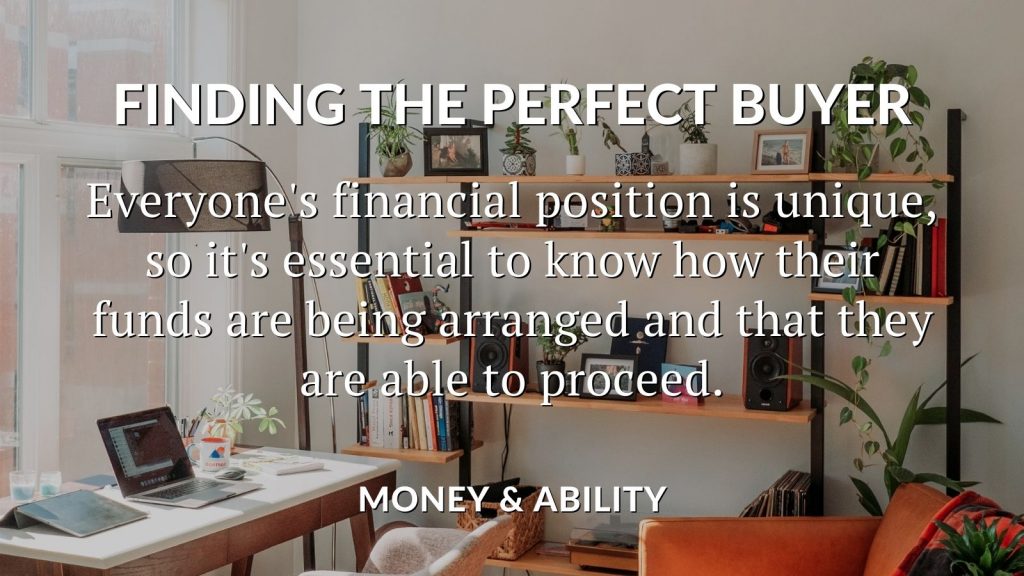
It’s not enough to ask if someone is getting a mortgage or paying with cash. Everyone’s financial position is unique, so it’s essential to know how their funds are being arranged.
If your buyer is taking out a mortgage, is it already agreed in principle? If they’re cash, and for any deposit monies, are those funds readily available, or are they tied up in multiple assets or accounts?
In the event of a chain, we confirm every link to ensure the foundations of an offer are sound. That means talking to every estate agent involved about how far the connected sales have advanced so that we can recommend a buyer with confidence.
And if you’re lucky enough to have more than one offer, you’ll want to be sure that the one you accept is the best combination of price, ability and timescale.
In summary
There’s plenty that goes into finding you the perfect buyer: appreciating the qualities of your home, taking an interest in why people are moving, and asking thoughtful questions are all part of the work. But when all those planets align, it makes for a simpler, smoother and more enjoyable move for everyone.
Are you thinking of selling your home soon? We’d love to hear your story and all about your plans. Call us on 042 933 2482 or email us at info@lavelles.ie; let’s get talking about where you’d like to go and when you want to get there, so we can help you on your way.
RENTAL UPGRADES: FIVE IMPROVEMENTS TO INCREASE YOUR INCOME

The rental market has grown up. Tenancies are running for longer, and with stays of four or more years increasingly common, tenants have higher expectations around the place they’re willing to call home.
This spells good news for landlords because those higher expectations come with a willingness to pay a higher rent. More than that, the right improvements will also increase the value of your property, giving you precious equity to finance and expand your portfolio.
But which improvements make the most difference?
There’s a fine balance to strike between spending too little, spending too much, and spending where it counts. The key is to create a contemporary and timeless home that’s durable and popular to give you wide and long-lasting appeal with minimal maintenance and repairs.
When we’re out on viewings, we see exactly what attracts people and excites them about their next home, and there’s no doubt that investing in presentation is rewarded in the quality of tenant and the rent achieved. If you’re considering making upgrades to your rental property, call us for a chat on 042 933 2482 or email us at info@lavelles.ie for some expert advice on getting it right.
But for now, let’s take a look at the improvements that will increase your income, attract high quality tenants and protect the value of your property.
PAINT
From the second the front door opens, the condition of the walls will be staring your viewers in the face, creating their first and immediate impression of your property.
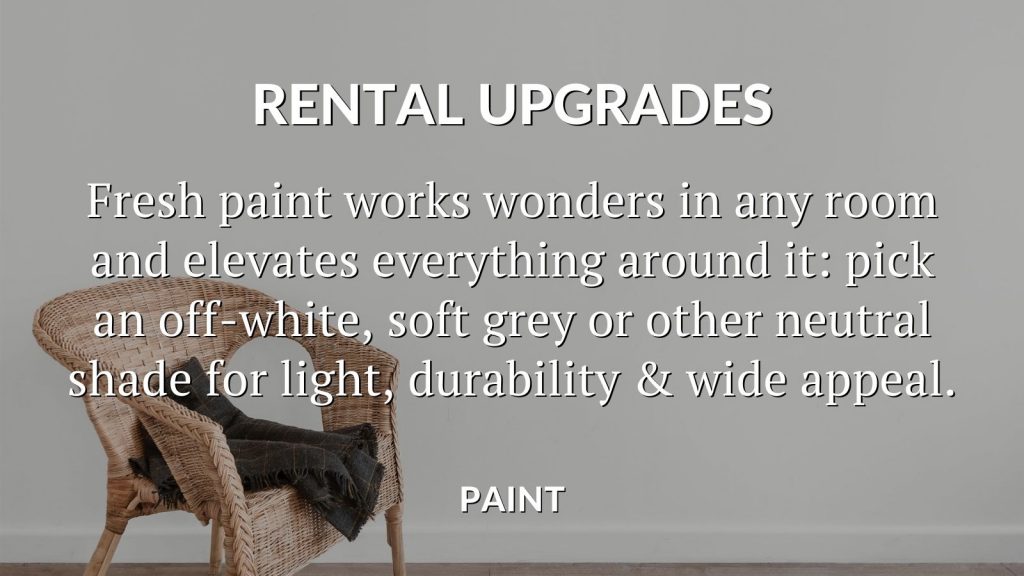
Scuffed walls look dingy and, despite being entirely cosmetic, have a deeply negative impact on viewings. On the other hand, a fresh coat of paint works wonders in any room and elevates everything around it, making it remarkably good value.
Although brilliant white is undeniably bright and a great reflector of light, some tenants find it a bit cold. It’s also a magnet for marks! Choose an off-white, soft grey or other classic neutral to give the walls a welcoming hue, with matt white on the ceilings, and white satin or eggshell for the woodwork.
KITCHENS
You’ll be pleased to know that not every kitchen upgrade means ripping out the old one and starting again. You can replace doors, handles, splashbacks or worktops for an instant improvement, so look carefully at whether the whole thing really needs to go.
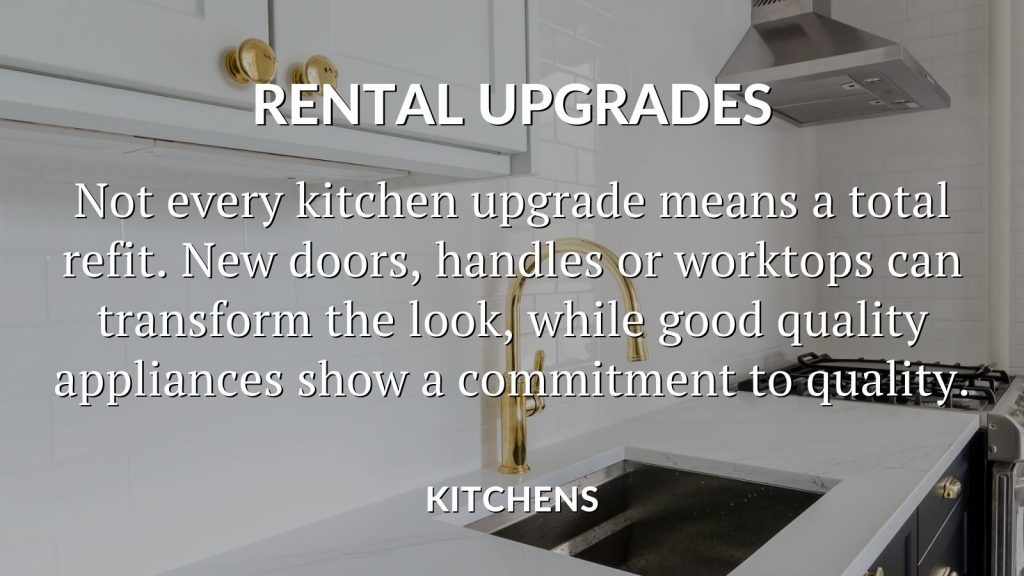
Whether you’re choosing a total refit or replacing selected elements, follow these rules for an enduring, impressive and low-maintenance kitchen:
- flat-fronted drawers and doors have sleek clean lines and are the easiest to maintain, with white and grey always in vogue and simple to accessorise;
- brushed steel handles are modern classics and will complement any style and colour you choose;
- metro tiles for splashbacks are eternally stylish and can add a burst of colour or a contrasting shade;
- worktops in composite stone or high-quality laminate look smart and are low maintenance, while quartz and granite add a luxurious finish if you want to go higher end. Solid wood tops look great but they need looking after, and the regular oiling and extra work required can make them less practical or appealing.
The presence and quality of appliances attracts more scrutiny than it used to: a dishwasher is no longer seen as a luxury item; an old-fashioned electric hot plate makes cooking seem like a chore; and a washing machine with a small load capacity means continual washday blues.
Investing in well-respected and reliable mid-range brands like Bosch, AEG and Neff is a visible demonstration of your commitment to quality: they make living in your property more enjoyable and tenants love them. You’ll also have long-lasting appliances that need less maintenance and ongoing expenditure, which means less hassle all round.
FLOORS
Floors take a real battering. Everyone walks all over them; furniture sits and moves about on them; bags, suitcases, bikes, strollers and pets all take their toll.
While carpets are soft to walk on, they can become worn and accumulate lines of dust at the bottom of doors, or imprints from previous furniture. Cheap laminate can look good when it’s fitted, but often peels at the edges, lifts at the joins and chips very easily. All this can leave your property looking unkempt and uninviting, negatively impacting your rent.
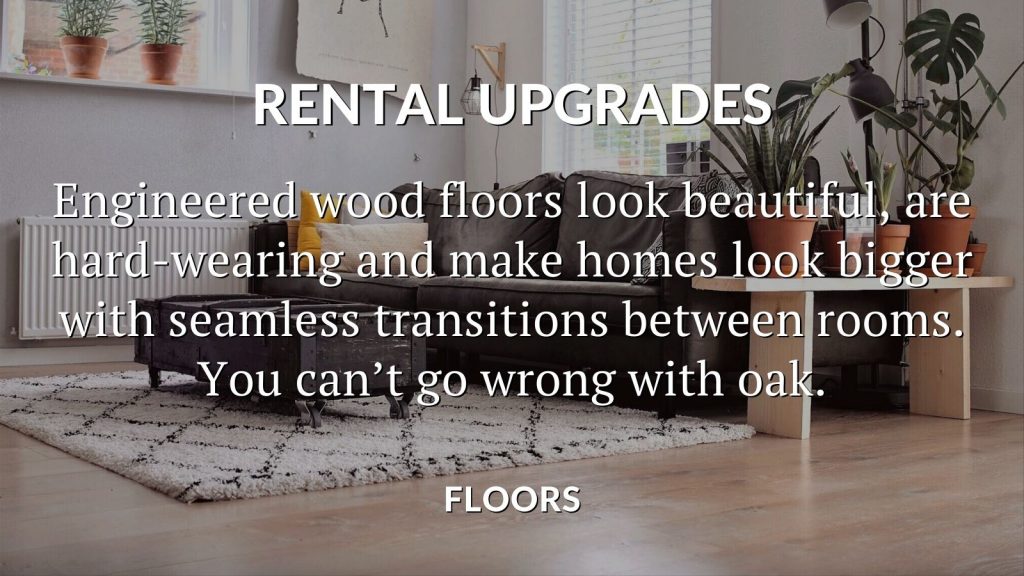
Engineered wood floors in living areas, halls and bedrooms look smart, are hard-wearing and can make your property look bigger when laid throughout. With a top surface of real wood, they’re a more authentic and luxurious alternative to laminate, but don’t come with the price tag of solid planks or parquet. They also last longer and can be sanded down when the surface becomes worn, giving you many years of service.
Medium oak is a classic, safe choice that will go with most people’s furniture: it looks great with pretty much anything and your tenants can accessorise with their own choice of rug for some underfoot comfort. If your property is particularly bright, you could add some drama with a darker wood like walnut. Pale woods like birch and maple reflect the light, but they can be more susceptible to marks as well as showing dirt and dust in the joins.
BATHROOMS
Tenants regularly ask us if they can test the water pressure on viewings, so a powerful thermostatic shower is a priority – dribbling hoses with fluctuating temperatures no longer cut it. People want an invigorating shower experience to start their day, so put them in a good mood every morning, rather than looking for a new place to live.
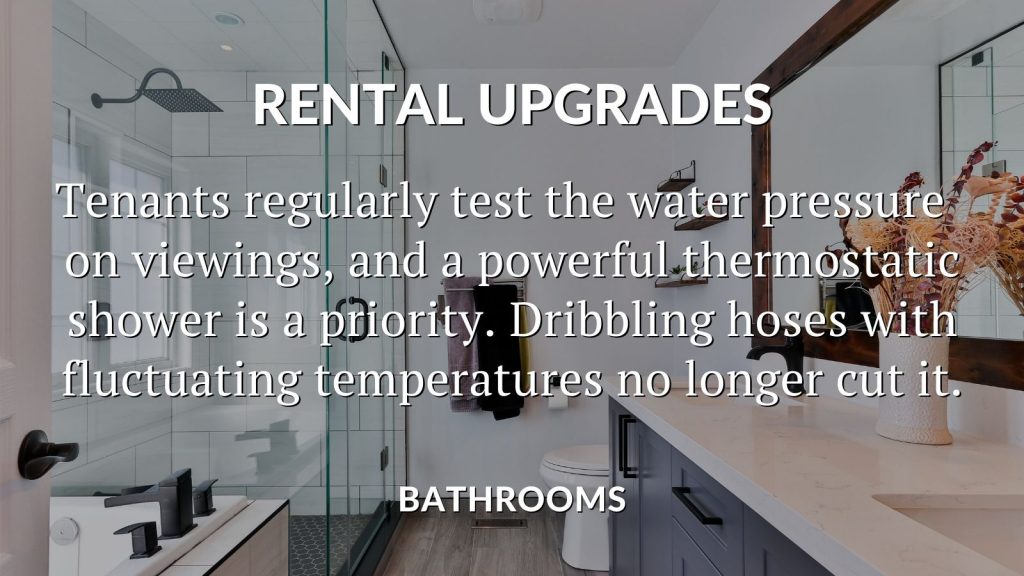
If your bathroom needs replacing, a plain white modern suite, warmed by grey floor and wall tiles, will provide a timeless contemporary style with universal appeal. Don’t skimp on the taps – you’ll soon be replacing parts if you go for the cheapest option, and the costs of repairs will eliminate your initial savings. Choose metal finishes like chrome, brushed steel and nickel: they never go out of style and they’re easier to maintain than taps with coloured lacquers.
Storage is vital to avoid an ocean of products piling up, gathering dust and making life difficult. The ideal solution is a vanity unit with a cupboard or drawers below the washbasin, and a mirrored cabinet above.
GARDENS
A modern, inviting and low-maintenance outdoor space is a definite winner, even more so since Covid-19 made getting outside feel like a privilege.

You don’t need to recreate the Chelsea Flower Show: in fact, keeping it simple and manageable will win you fans without presenting an overwhelming display of pruning duties. No matter how much they enjoy being outdoors, not every tenant is an expert gardener.
A patio or deck with a paved or timber surface provides a year-round usable space that’s easy to keep clean and looks way better than raw cement. Paired with exterior lighting, you’re effectively giving your tenants another room, day and night, for which they’ll happily pay.
Add a few pots planted with spring and summer perennials that bloom again every year, and your tenants will have a colourful, seasonal space where they only need to add water (and much of that is taken care of by our national climate!)
In summary
With proper execution, making improvements to your rental property will increase your income, attract higher quality tenants, reduce void periods and future-proof your property’s value. There’s no one-size-fits-all amount when it comes to budget, but we’re here to help you invest in the things that really matter.
Are you a landlord with a property to rent in County Louth? If you’d like to increase your income while keeping your costs under control, why not get in touch? Call us on 042 933 2482 or drop us a line at lettings@kelwaylaw.co.uk– we’ll help you set the right budget and do the right thing to attract the best tenant and rent.
GARDEN REVIVALS: SIMPLE & INSTANT TIPS TO BE READY FOR SPRING VIEWINGS
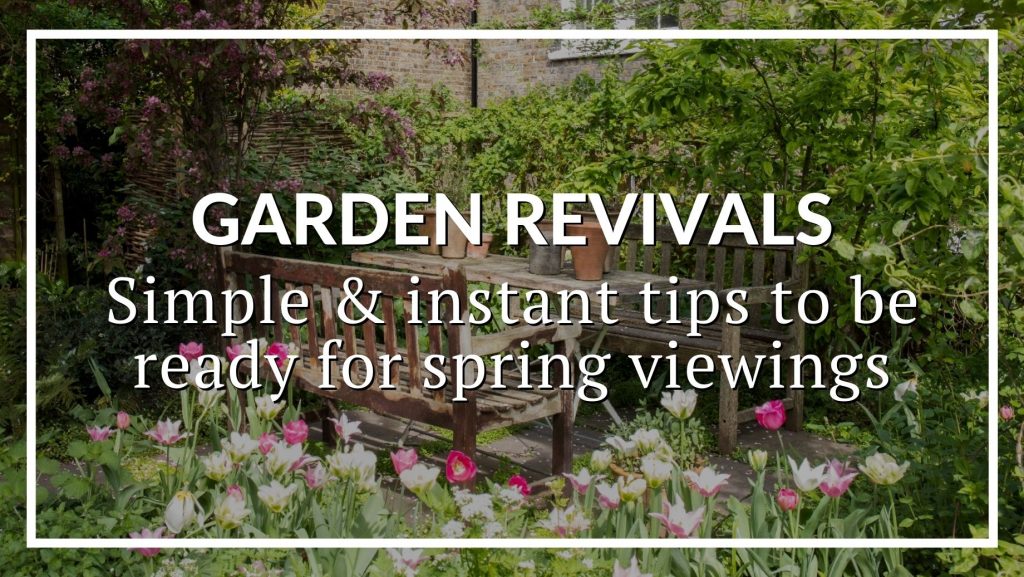
The weather may be confusing, but one thing is for sure: Spring is springing.
One of the biggest effects of lockdown on the 2020 property market was a massive surge of interest among buyers for gardens and balconies, and not just from green-fingered enthusiasts. People who’d never given gardens a second thought were suddenly sold on the value of being outside at home, and the demand went through the roof.
That blooming market has continued this year, with gardens and balconies still noticeably high priorities for buyers, so it’s really worth making the most of your outdoor space to maximise its value and amplify interest in your home.
Colourful spring flowers look wonderful in photographs and on viewings. From window boxes inviting people to view, to fully-planted borders encouraging them to stay, they bring a natural vibrancy that boosts any image or visit. Even if you didn’t plant any bulbs last year, you’ll see it’s not too late to have an enchanting display to captivate every viewer.
HEALTHY LAWNS
Grass rarely looks great after winter, but with increased sunshine encouraging active growth, it’s time for some TLC and dusting off that hibernating mower.

Wait for a few dry days in the forecast, then start with a trim on the highest setting when the ground is firm and free of dew: not only better for the grass and your mower, it’ll save you churning the soil into mud with the mower’s wheels.
Most lawns suit a length of 2-4cm, but where there’s lots of wear and tear or footfall, go a little longer at around 5cm. For very shady areas, up it to 7cm. Remember that grass is a plant and needs its blades working to photosynthesise, so don’t go scalping it!
Moss, dead grass and other debris can impede healthy growth, so remove them with a spring-tine rake. Use a garden fork or hollow-tined aerator to reduce waterlogging and improve drainage, or go for the hands-free option with a pair of aerating shoes.
Finish with a bit of top dressing and feed. With all-in-one products like Miracle-Gro Evergreen 4 in 1, you can fertilise the grass while treating weeds and moss.
PATIOS AND BALCONIES
It’s incredible how fast sludgy green growth like moss and algae can settle over winter on paving, decking and walls, but there are some easy and eco-friendly ways to tackle the job.

A jet washer will shift the weeds and muck. Not only highly effective, they’re incredibly satisfying to use – simply hook up to your water supply and get blasting! Use the highest setting on pavers and concrete to watch the dirt slide off like butter, while a lower setting for timber decking or walls with paint or render will avoid damaging the surface.
No outdoor tap? No problem! Widely-available organic cleaners like Algon are free of nasty chemicals, making them safe for pets and wildlife. They restore the natural colour of virtually any surface with no need to scrub or rinse: just apply with a sprayer, soft garden broom or paintbrush on a dry day, then walk away!
BUYING YOUR BLOOMS
This year’s fashionable planting trends are very much naturalistic and concentrate on supporting pollinators, but don’t panic if you’re a complete novice. You can find ready-made, expert-curated combinations to suit any setting, making it very hard to go wrong.

Websites like Suttons, Woolmans and J Parkers are great places to start and have so much to choose from. They mainly sell ‘plug plants’, which can be delivered right through your letterbox by the postman: equally perfect for containers or for spaces in the ground left by anything that didn’t quite make it through winter.
Many supermarkets have also expanded their plant and garden offerings this year, and you can buy a wide selection of tulips, narcissi and even bluebells when stocking up on your pantry essentials.
To stay on-trend through summer and autumn, mix in some salvias with your choice of spring blooms: cheap to buy, low on maintenance and varied in colour, there’s one for every taste, and they’ll flower through summer and autumn.
SMART PLANTING
Super-organised gardeners will have been out planting their bulbs last autumn, but you can still get beautiful results with pre-planted or ‘in the green’ bulbs.

A great trick to make your shop-bought bulbs go further is to separate them for planting. They’ll be potted close together in a bundle of competing roots, but by teasing them gently apart with your fingers, then spacing them out in your beds, you’ll see more of the individual blooms across a larger area.
Your bulbs will also perform much better as their roots begin to spread, soaking up all the nutrition and water they need in their spacious new home.
CONTAINER GARDENING
You don’t need a huge garden – or even a small one – to bring in the spring: flowers still look fabulous in pots, boxes and baskets. A bright selection of bulbs and bedders by your front door – or on your window sills – makes a cheery welcome for anyone viewing your home, either in person or online.
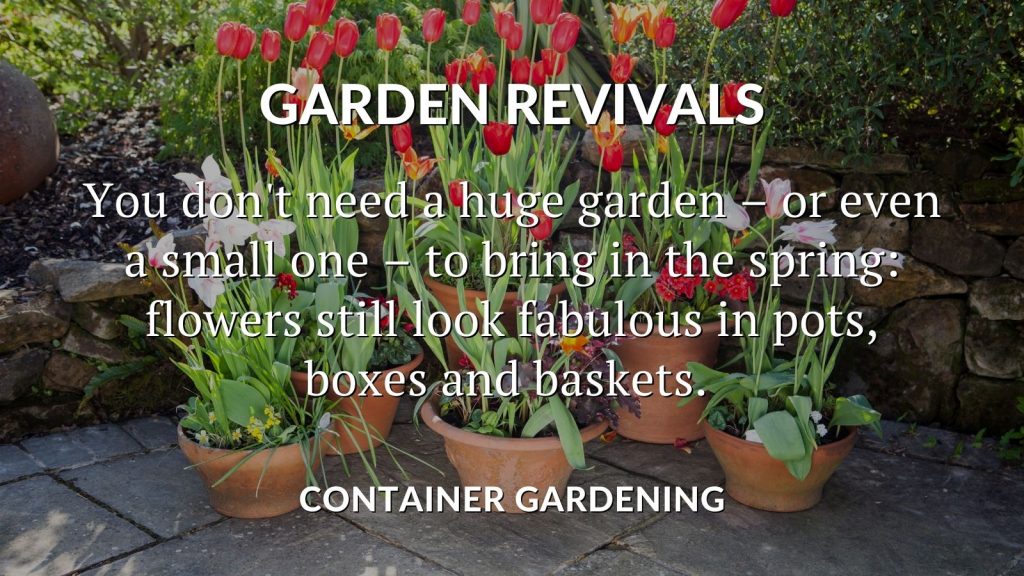
Classics like tulips and narcissi look brilliant when combined in containers, while primroses are another favourite at this time of year. The perfect companion for bulbs, they’ll naturalise too, giving you new plants year on year. Gorgeous in pots, there’s a reason they’re such eternal garden stalwarts.
For hanging baskets, try mixing fuchsias, petunias and lobelias. Keep them watered, and you’ll be rewarded with a glorious eye-level display of interest, colour and form.
In summary
A spring clean and some clever planting will give you immediate seasonal colour that buyers will love and that you can enjoy right now. There’s no time like the present, so go outside, soak up some vitamin D and get your hands in some soil: it’s good for the soul, and great for your sale!
If you have a property in County Louth and you’re making plans to sell, we’d love to help you get your seasonal presentation just right. Get in touch today on 042 933 2482 or email us at info@lavelles.ie , and let’s work together to put the spring into your move.
RENT ARREARS: FINDING A BALANCE BETWEEN COMPASSION AND COLLECTION
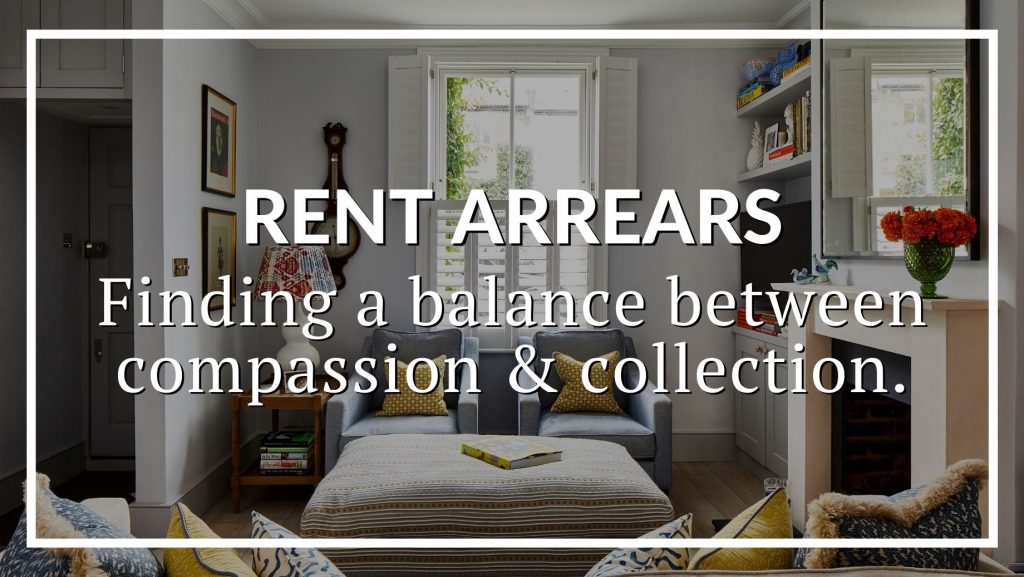
Although rent arrears have been a hot topic during the pandemic, it’s far from being a new subject. That said, if the discussion has taught us anything in the last year, it’s that anyone can be affected by economic events: no-one is immune, however high their income.
Most tenancies run their course without arrears building up, but that means landlords and tenants have little experience to draw on when payments fall behind. Regardless of how and why they happen, arrears can be a source of friction and provoke all sorts of feelings and emotions around the possible repercussions.
For a self-managing landlord, it’s vital to keep a level head when discussing arrears with your tenants. That might be challenging when their financial circumstances impact your own, but it’s essential to avoid communication breaking down.
If you’re unsure of how to approach any rent arrears at your rental property, you’re welcome to get in touch. Part of a managing agent’s role is to keep things polite and professional before they get too personal, which makes us well versed in acting as a cushion between emotions. So if you’d like some words of wisdom, or you’d like someone to handle things on your behalf, call us on 042 933 2482 or email us at info@lavelles.ie.
Money can be a touchy subject, but as you’ll discover in this week’s article, there are many ways to keep the conversation going without sinking into acrimony or legal proceedings.
GET THE FULL STORY
You’d be right in feeling you shouldn’t have to chase your tenants about their arrears, but your tenants could well be terrified of contacting you. They might feel poorly equipped for an unpleasant or difficult discussion, and they may even be hugely embarrassed.
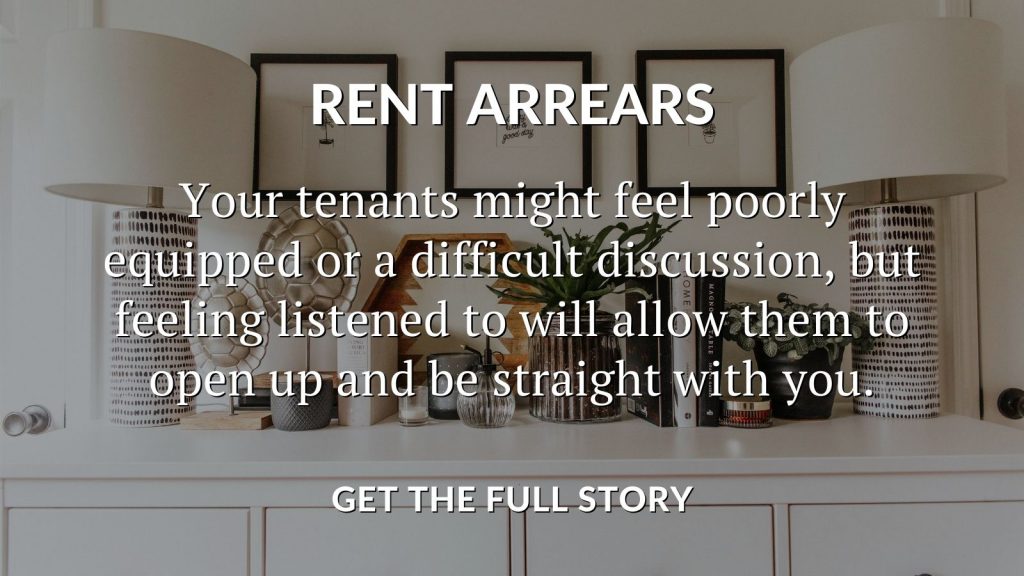
The key is to make it clear that you acknowledge whatever predicament your tenants find themselves in and that you’d like to properly understand what’s happening in their lives to find the most practical solution.
Feeling listened to will allow your tenants to open up and be completely straight with you while concentrating on the facts, and getting a clear and detailed picture will help you keep a calmer disposition.
FIND QUICK FIXES
Your tenants may have simply hit a temporary glitch, so the first question to ask is: what can they pay right now? By exploring options beyond all-or-nothing, you could agree on a short period of reduced rent, with the arrears spread across future payments over a set number of months.
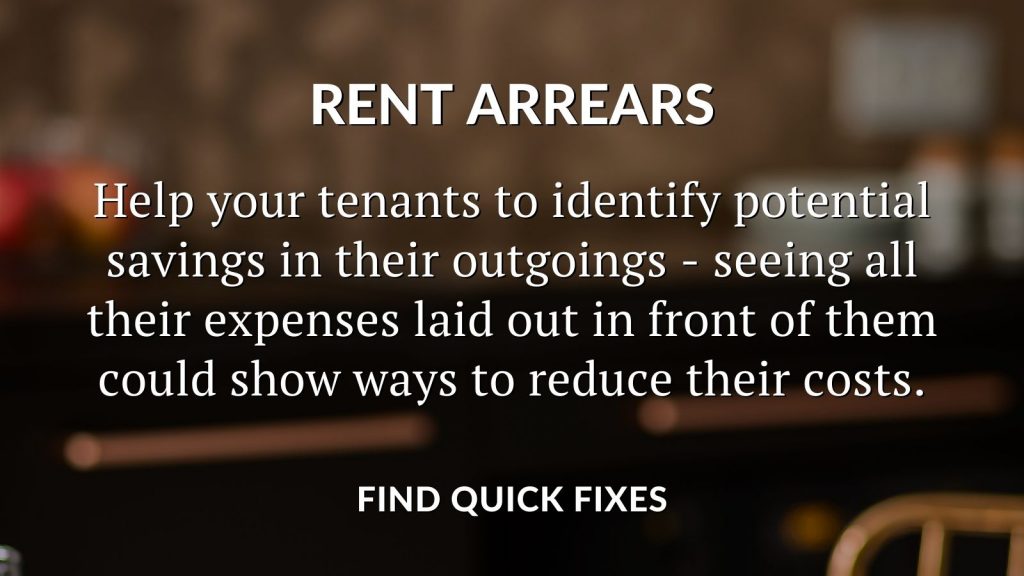
You could also help your tenants to identify potential savings in their other outgoings to use towards their rent. Just as lenders ask borrowers to write down all their monthly expenses, you can invite your tenants to do the same. Having it all laid out in front of them may open their eyes to ways of reducing their costs.
Daily habits and direct debits can mount up without us realising. It’s not hard to clock up hundreds of pounds per month on coffees to go, club memberships or entertainment subscriptions: pressing pause for a while could help your tenants make a swift and significant dent in their arrears.
If they have other debts attracting interest, would they be better off by transferring their balance to a 0% card? Not everyone keeps on top of current rates, and the combination of reduced payments and savings on interest could put your tenants in a better financial position, freeing up money to catch up on their rent.
BORROWING & BENEFITS
If you have a longstanding relationship and your tenants have been exemplary until now, you may well want to keep them, which is as good a motivator as any for helping them to find a solution.
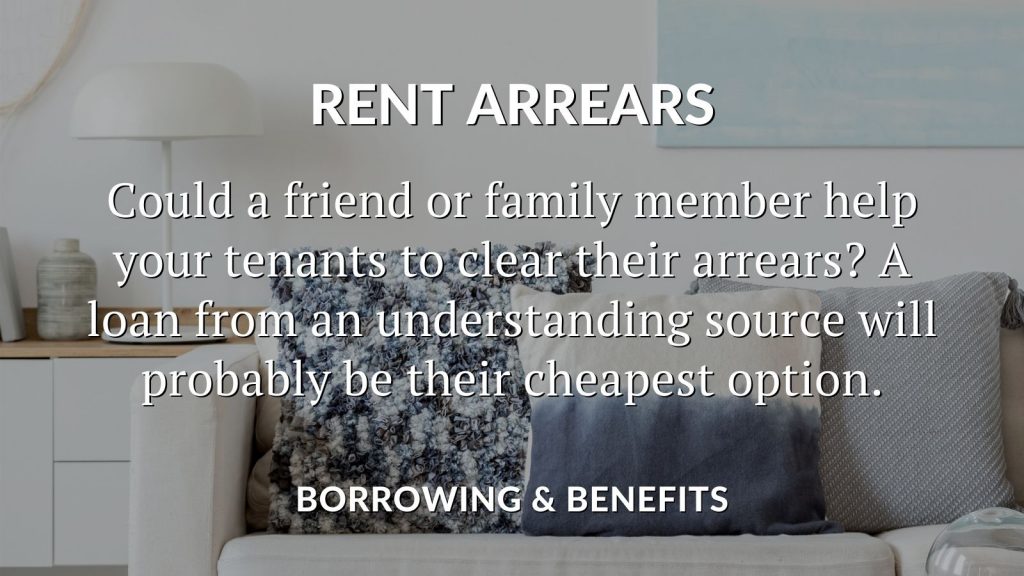
Could they borrow from a family member or friend to clear their arrears? Coming from an understanding source, it will almost certainly be the cheapest option and probably the most flexible.
If your tenants still have an income and they’re not heavily in debt, a personal loan from a bank might provide an appropriate answer, particularly with low interest rates. Unlike landlords, lenders are designed for borrowers to split their payments into small amounts over many years, and the cushion of an extended repayment period could allow your tenants to catch up on their rent immediately without having to find all the money upfront.
If the situation is more drastic and your tenants have lost their income, point them in the direction of the Citizens Advice Bureau. They should be actively encouraged to find out whether they are entitled to any support and when it will be available to them.
CONTACT GUARANTORS
If a guarantor was named on the tenancy agreement, you can approach them for payment.
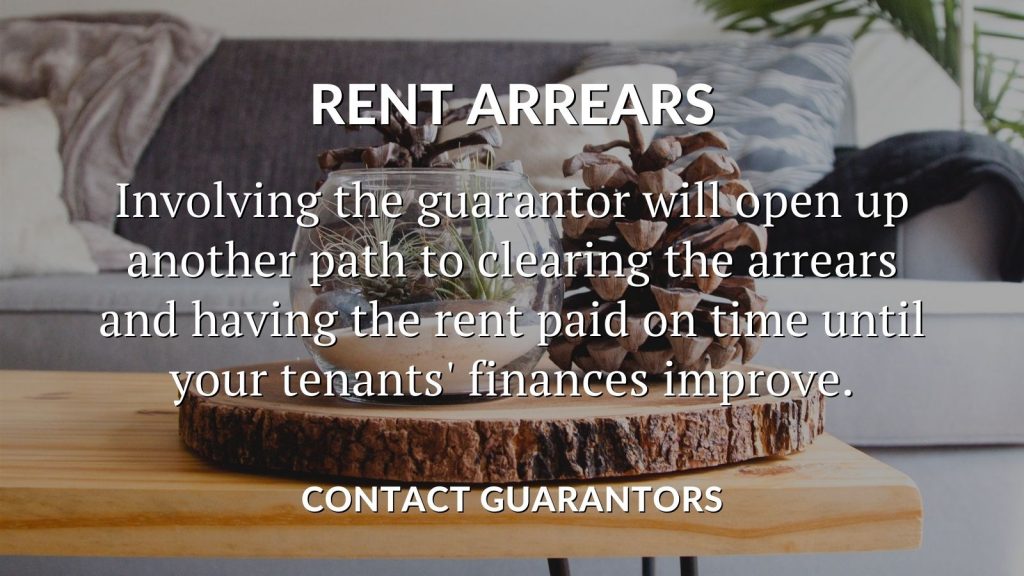
You’re entitled to write to the guarantor as soon as the rent falls behind, but most tenants would prefer to find a solution directly with their landlord if at all possible, and they’ll appreciate your attempts at working something out with them first. That’s because guarantors are very often parents, and tenants can experience a level of embarrassment in feeling they still need to be rescued by mum and dad.
Nonetheless, the whole reason for having a guarantor is to provide a safeguard in the event of your tenants not being able to pay their rent. Involving the guarantor will open up another path to clearing the arrears and having the rent paid on time until your tenants’ financial position improves.
LET YOUR TENANT GO
Most tenants don’t voluntarily choose to stop paying their rent. They could be suffering severe financial hardship from whatever circumstances they find themselves in, and their rental contract might be adding to the problem. Sometimes, something has to give.
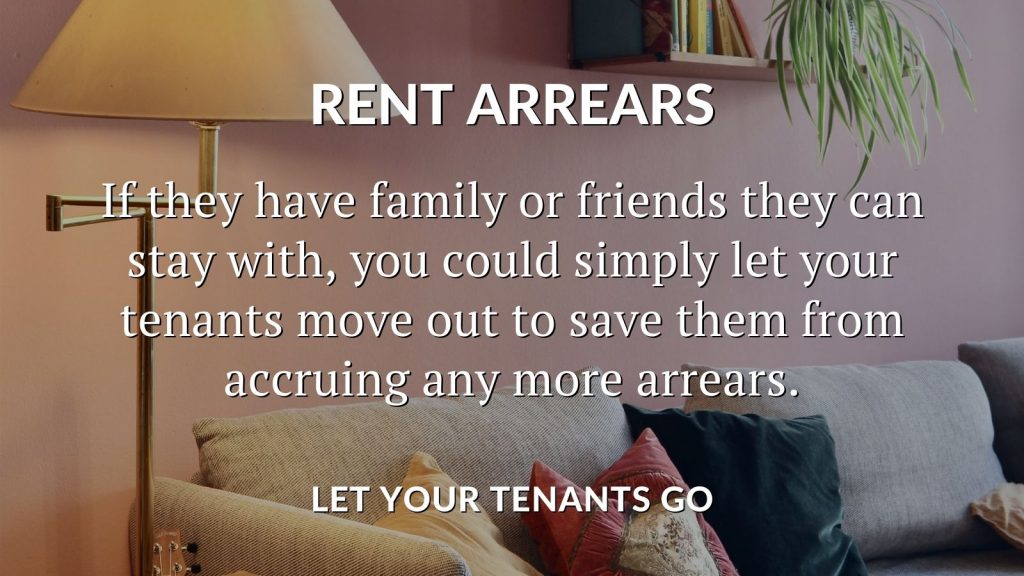
With or without eviction bans, you could simply let your tenants move out to save them accruing any more arrears. If they have family or friends they can stay with, the money they save on bills and rent will allow them to repay you faster and could solve three problems in one:
you prevent the arrears building up any further;
you provide a route for your tenants to repay what they owe;
you get to find a new tenant, so your rental property can produce income again.
The exact wording and requirements of tenancy agreements are there to hold everyone to their responsibilities, but there are occasions when letting go can provide a more practical answer.
In summary
There’s no doubt that dealing with rent arrears can be a challenge. While it might be little financial comfort, you can be sure your tenants will be just as uncomfortable having so much uncertainty hanging over their lives as well.
Peace of mind comes from staying on top of problems when they arise, rather than letting them fester. Some self-managing landlords cope with that perfectly well and have enough knowledge and confidence to be unphased by difficult discussions with tenants. Others prefer a quieter life, opting for a managing agent’s experience and capacity to act on their behalf.
Either option is fine, but if you’d like to explore having your rental property looked after for you, or you’ve got any questions about being a landlord, you’re welcome to get in touch. Call us for a chat on 042 933 2482 or email us at info@lavelles.ie – we’re here to make your life easy.
WHAT DO BUYERS WANT? FIVE FUNDAMENTAL FACTORS THAT TURN VIEWINGS INTO SALES

We’ve all had that sense of all-consuming joy when finding the home of our dreams, and what a feeling it is! Excitement, anticipation and nerves all rolled into a single moment, and much of it unquantifiable.
There’s a lot that goes into a decision to buy, from emotional, financial and intellectual reasons to a healthy dose of gut-feeling. And while practical considerations like size, price and fittings certainly play their part, they all take a back seat to the most influential factor of all: how a home feels. Is it ‘the one’?
The feeling goes way beyond the phrase ‘location location location’ because people live in all sorts of places for all kinds of reasons, many of them non-negotiable. A school’s catchment area; a particular station for a quick commute; moving closer to a family member; being in a specific street or neighbourhood: these create the framework for many property searches.
But as soon as viewings begin, it’s the physical experience of each home that comes into play. Much of that includes condition and character, but there are other, less obvious ways of helping a buyer to say yes to the only question that really matters: “Could I be happy here?”
It’s never too early to talk about how to get your home ready to sell, so do get in touch if you’re not yet sure where to start. Call us for a chat on 042 933 2482 or email us at info@lavelles.ie – let us know what you’re thinking, and we’ll help in any way we can.
Meanwhile, let’s look at how you can help a buyer to see your current home as their next one.
VISIBLE FLOOR SPACE
When it comes to pure bang for your buck, what really counts is visible floor space. A plan shows the technical details, but it doesn’t tell the whole story. It’s only when standing inside your home that someone will get the sense of how big – or small – it feels in person.

To optimise your photos and viewings, it’s essential to factor in movement and sight-lines. When we bring someone to see your home, there’ll be at least two people, possibly three, and maybe even a whole family walking around at the same time, so if there are obstacles to seeing an entire room, you’ll be giving the sense of a lack of space.
If a buyer needs to shuffle around furniture or there’s nowhere to move inside a room, there’s probably too much in it to give you the best chance of selling. Try changing the position of a couch or coffee table, or removing an armchair or footstool: small changes like these can dramatically improve your photographs and transform reactions on viewings.
Aside from furniture, think about what else is in the room. Do you have piles of magazines, books or vinyl on the floor? Their presence can create a sense of warmth and comfort, but they should either go onto shelves – or put away out of sight – for the time your home is on the market.
There’s a fine line between a room being emptied of clutter and a room feeling cold and bare, and we’ll help you strike the perfect balance.
FUNCTIONALITY & PURPOSE
Interior stylists and designers often cry: “there’s nothing worse than a spare room.” They’re right, and when a room doesn’t have a function, its value is reduced. Not every buyer can visualise a desk, bookshelves, easy chair and elegantly-painted walls.

You’ve probably seen pictures of show homes or maybe even visited some. House-builders know that standing people inside a series of empty rooms – or among building materials – simply doesn’t portray the lifestyle available. The same is true for lived-in homes.
Spare rooms can develop over time and you can get so used to them that you no longer notice. Perhaps you’ve stopped using a bedroom since a family member moved out, or maybe you never occupied one as intended. It’s completely normal, but once a room starts collecting boxes or junk, its purpose and functionality become unclear.
Furnishings and accessories enhance a room and highlight its features. Think of a reading chair in a bay window, a hearth rug in front of a fireplace, or even books on shelves: you won’t be leaving any of them behind, but they show purpose, function and possibility.
Find another home for the boxes, and if you have an empty room, look at relocating furnishings or accessories from elsewhere. Perhaps you can create a study, reading room or workspace to add extra purpose and maximise your home’s appeal.
POTENTIAL (SOMETIMES)
The P-word can be highly potent, and we often meet buyers who are willing – and even hoping – to improve, extend or upgrade a home. Potential can be a true enabler of interest, widening your market beyond the limits of your home’s current accommodation or offer. But that potential needs to be qualified.

Simply declaring that an extension could provide another two bedrooms and an extra bathroom isn’t necessarily enough: you need to demonstrate how possible and probable it is. By making it simple for a viewer to visualise themselves in that new space and how it could work for them, you’ll add credibility, excitement and value.
Sometimes, it’s easy. A similar extension or remodelling that your home could take might have been completed nearby, with photos that show the finished result.
Otherwise, and if your home has the potential for a unique or particular expansion, get some plans drawn up by an architect. Going one step further still, gaining full planning consent to carry out the works will give a buyer complete certainty and help you achieve a higher price.
A CLEAR PROPOSITION
Imagine going to view a total wreck; somewhere that’s not been updated for decades and where everything clearly needs doing. Now think of a home where everything is perfect and where tons of love has gone into creating a wonderful, beautiful place to live.
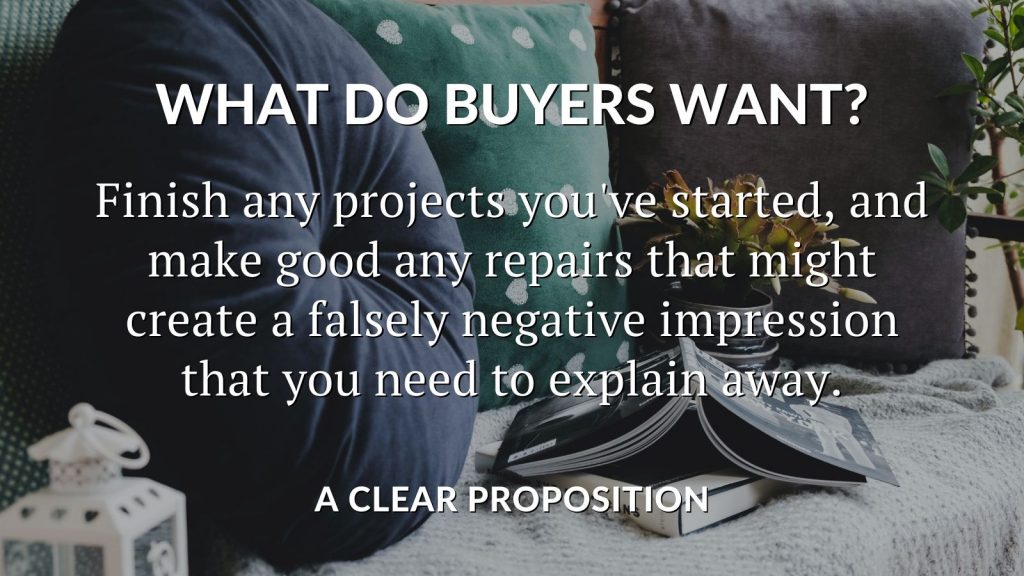
These two extremes of condition and presentation share one common quality: clarity. You have the sense that you know exactly what you’re getting and what you’re taking on: it’s either a real fixer-upper or a ready-made home.
In the middle are the halfway-houses that, in some way, throw in doubts, and often from unfinished projects. Maybe you’ve removed all the wallpaper from a room and haven’t yet redecorated, leaving the old, unsightly plasterwork exposed. Perhaps you replaced your kitchen or bathroom fittings but never completed the tiling, leaving your renovations – and financial investment – looking less attractive and even less valuable.
This lack of clarity isn’t limited to improvements; it can also affect maintenance and repairs. You could have fixed a leak, but leaving a historic water stain on a ceiling or wall can raise questions over potential plumbing, roof or damp problems. Or that peeling paint on your window frames can leave them looking in need of replacement, rather than simply a sanding and fresh coat.
Relatively small issues like these can negatively affect a buyer’s thoughts about your home. So finish what you’ve started, and make good anything that’s creating a falsely negative impression.
FUTURE SALEABILITY
People like to feel comfortable that the property they’re thinking of buying is somewhere they’ll be able to sell. Not every home is a forever home, and a buyer could be looking at yours as a stepping stone to their future goals. In short, nobody wants to get stuck.

Are there any unsaleable properties? Not really, but some can look unpopular, and that’s often down to how long they’ve been on the market. With so much information readily available on the national portals, from when a property first came on the market to all its subsequent price reductions, a list of evidence soon begins to build.
Perception is hugely important. Multiple price reductions don’t always look like a bargain to buyers; more often, they suggest a property that nobody wants and can lose the perfect new owner before they even view. We don’t always get to find out why someone chooses not to call, but we do know that when homes sit on the market, they don’t become more attractive.
If you’re ever tempted to try a higher price when you first put your home up for sale, don’t let it drag on: you’ll know within a couple of weeks whether it was the right decision. If you get no interest at all – or if everyone who views says your home is too expensive – you’ll know what you need to do.
And if your home has been on the market for some time, you could well be better off with an altogether new strategy. As well as providing a fresh perspective and energy, switching agents will give you an automatic reset on the property portals, restoring that valuable “new listing” status for an invigorating restart.
In summary
Much of someone’s decision to buy is outside your control, but you can have a considerable influence through the viewing experience you create. By removing potential obstacles and objections and replacing them with clarity and credibility, you make it easy for a buyer to see your home as the most exciting and enticing choice.
Would you like to maximise the saleability and attraction of your home? If you have a property to sell in County Louth, we’d love to show you how we can help. Call for a chat on 042 933 2482 or email us at info@lavelles.ie– there’s a lot to do when moving home, so let’s get talking soon.
PROOF POSITIVE: 5 SIMPLE SECRETS TO MAKE YOUR INVENTORY WATERTIGHT
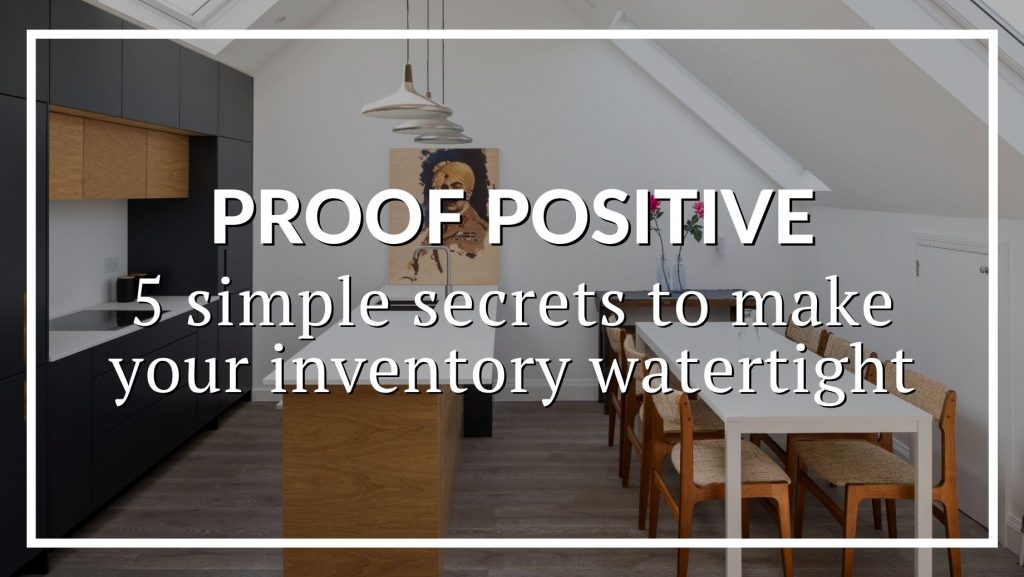
Not every inventory ends up providing the protection that landlords expect. There are plenty of cases where the language used – and the style adopted – have caused more confusion and doubt over disputes, which for a landlord will generally mean a reduced or refused claim.
Inventories are essential to have complete clarity over the condition and contents of your rental property: without correct preparation, you’ll not only risk a costly dispute, but you’ll also sow the seeds of worry in your tenants. The more documentation you have that you can agree on from the outset, the more professional you’ll look as a landlord and the more comfortable your tenants will feel.
Whether you’re preparing a paper or digital inventory, you must ensure it’s signed off by you (or your managing agent) and your tenants. But as you’ll discover below, there’s more to it than that.
If you own a rental property in County Louth and you’d like to know more about best practice when preparing inventories, do get in touch. Call us for a chat on 042 933 2482 or email us at info@lavelles.ie– you’ll always find an expert ear happy to guide you.
Meanwhile, let’s take a look at how you can make your inventory the best it can be to give you, your property and your tenants maximum protection.
BEYOND BOX-TICKING
Some landlords still rely on checklist-style inventories, which simply aren’t enough to reflect the contents of a property accurately. More than that, they’re completely useless when it comes to being clear about the condition of every fixture, fitting and, where supplied, furnishing.

We can’t stress enough that inventories are so much more than box-ticking exercises, and a correctly prepared report can easily run to 30+ pages – more if your property is furnished. There’s a lot of time involved in writing down every last detail, but even if you have complete confidence and trust in your tenants, it’s in both your best interests to go deep. So if your inventory is just a few pages long, it’s unlikely to be of any use in a dispute.
That’s why an inventory clerk is so invaluable. Not only do they save you the time and hassle of detailing every last thing yourself, but they’re also a third party with no emotional or financial attachment to the property. They’re guided only by what they see, and their expertise and independence give their inventories an extra layer of credibility, priceless if you end up in arbitration or the courts.
Remember: it’s your responsibility as a landlord to prove that any damages or repair costs are down to your tenants.
MIND YOUR LANGUAGE
Problems with disputes can often come down to the language used in the inventory. It’s not because they’re written in French or Norwegian, but because they use emotive and subjective words.
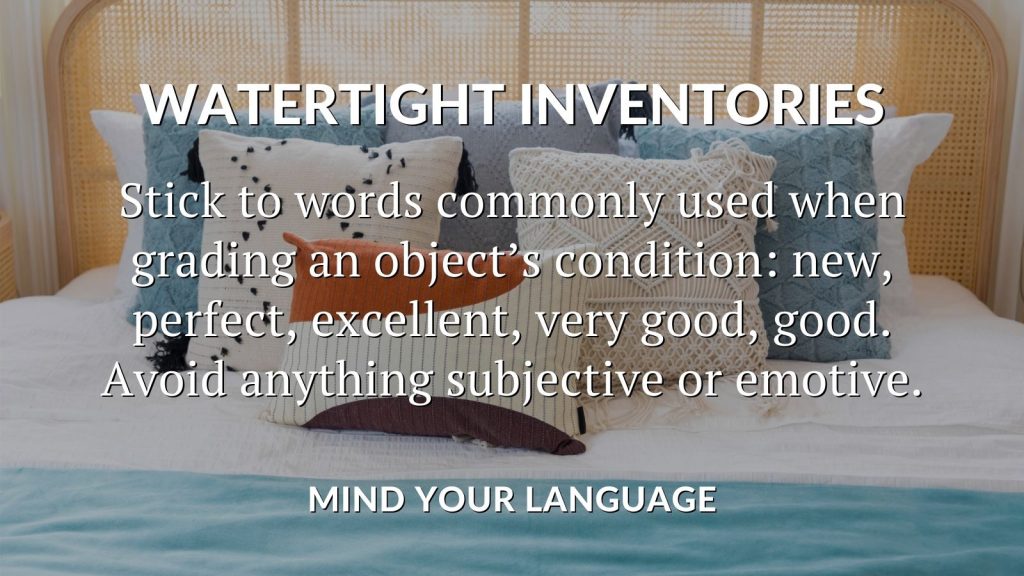
One example is the word lovely, which, in property terms, is best confined to an estate agent’s description of a charming location. It really shouldn’t form part of how you describe the contents or condition of anything in your property.
Stick to words commonly used when grading an object’s condition: new, perfect, excellent, very good, good. Hopefully, you’ll have no cause to use below average, poor or unusable, but if you do, you’re best off fixing anything in that category for the sake of starting your tenancy on the right foot.
Emotive language may well come from your pride in your property and generally appears when self-managing landlords write their own inventory. It’s completely understandable, but it’s no help to you in the event of a dispute. Keep it neutral and objective.
THE DEVIL’S IN THE DETAIL
Inventories aren’t just about listing objects; they’re about giving an accurate picture of your property’s condition and presentation when you hand over the keys to your tenants. So as well as stating everything that’s there, you also need to say what isn’t.
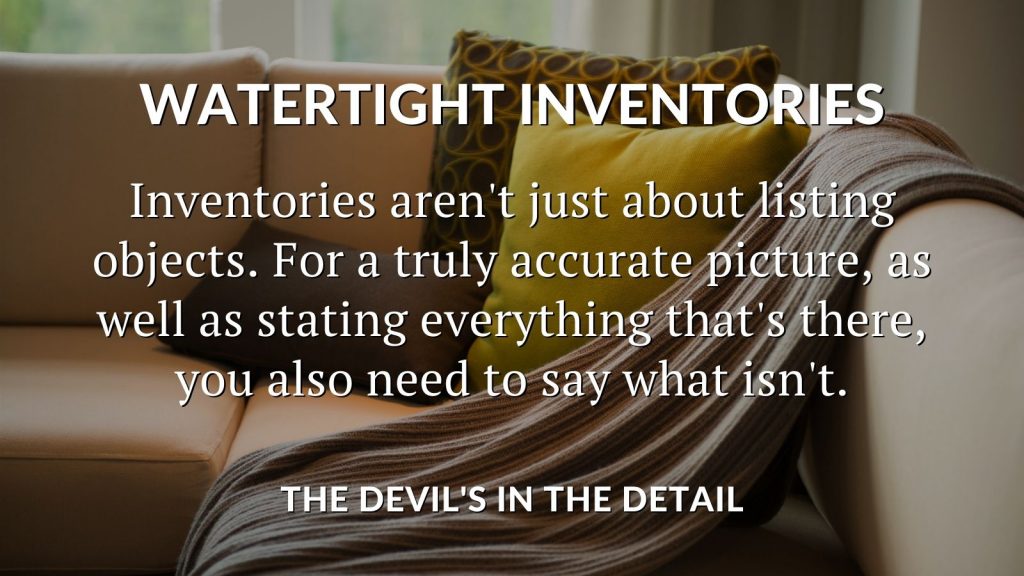
Minor scuffs that don’t yet warrant any remedial works should be mentioned along with exactly where they are on a wall or paintwork. The same goes for marks on a carpet or floor that aren’t serious but are nonetheless visible: be very clear about exactly where they are. And when it comes to stains, whether relatively unobtrusive or relatively obvious, make sure to measure them as well as mention them, and to state their exact location.
Now let’s look at things that aren’t there. Accidents happen, and a couple of more common mishaps are irons on floors and saucepans on worktops. So it’s really worth mentioning that there are no burn marks: not just to state the truth, but to plant the seed in the minds of your tenants to be mindful of where they leave hot objects.
Where bathrooms and kitchens are free of mould and limescale, be sure to mention that too. Again, it’s a clear statement that everything is looking good and provides a gentle reminder for your tenants to keep their eyes peeled.
By being ultra-specific and going into detail, you minimise the potential for uncertainty in the future.
PHOTOGRAPH EVERYTHING
You can never have too many pictures.
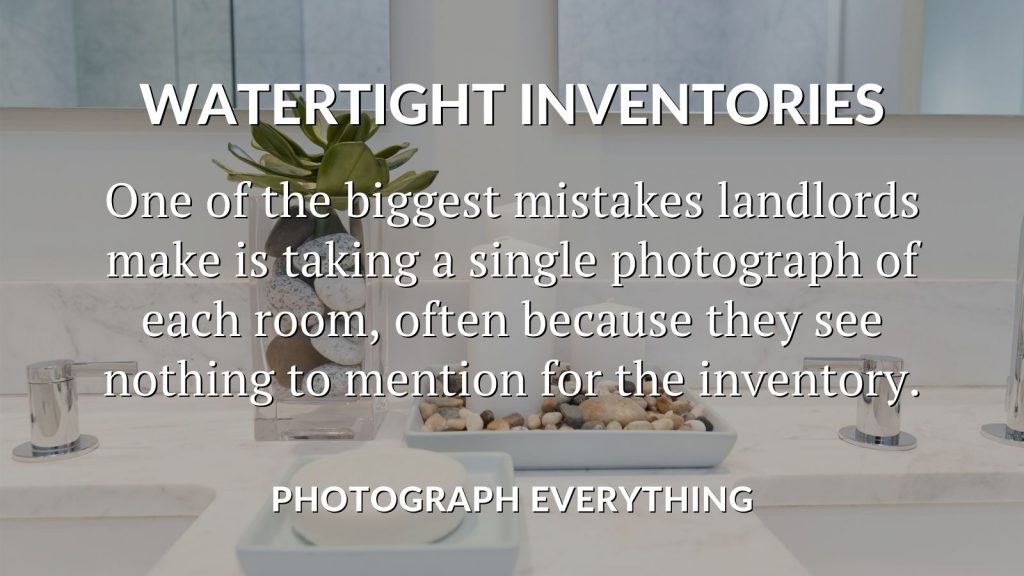
One of the biggest mistakes landlords make is taking a single photograph of each room, often because they see nothing to mention on the inventory—a quick note that everything’s fine, and then onto the next room.
How can you take a photo of a scuff mark that isn’t there, or damage that doesn’t exist, or a breakage that hasn’t occurred? Well, you can’t, but you can take photos to show that all those things are in perfect condition. It’s not enough to say it; you need to show it.
As well as photographs, videos are easier than ever to take from your phone. Wander around your property and get close-ups of everything: switches, sockets, hinges, handles, walls, skirting boards, bathroom fittings, kitchen cupboards and appliances, heating systems, floor coverings, window frames, gardens.
Share them with your tenants, agree on their accuracy, and then sign them off together. By showing how responsible you are as a landlord and leaving nothing to chance, you give your tenants certainty of not being charged for anything unfair, and you send a clear message of how they should return your property.
HIDDEN BENEFITS
We generally speak of inventories as a failsafe in disputes, but they also play another role.
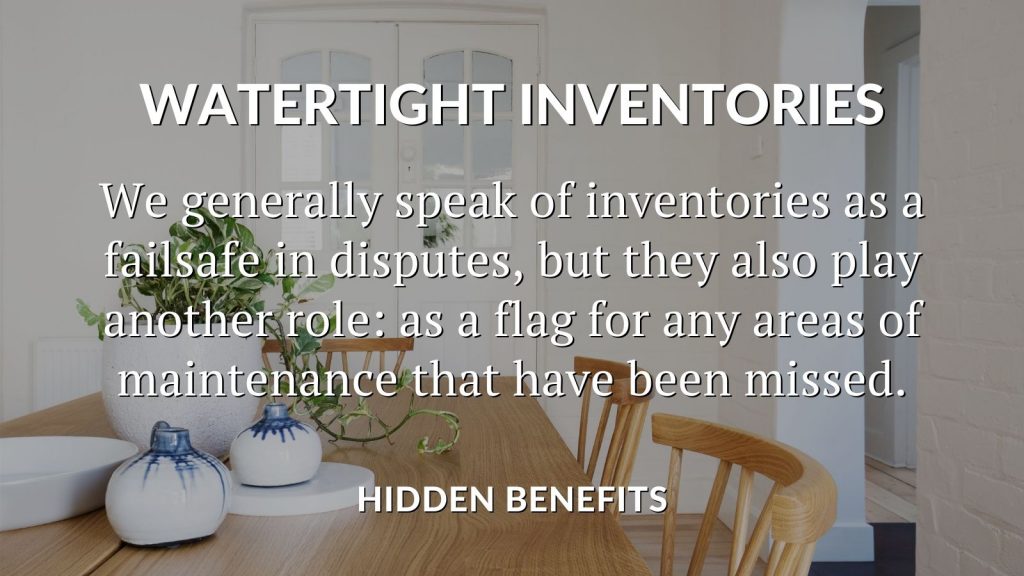
Properties need to be regularly maintained, and inventories can act as a flag for any maintenance areas that have gone unnoticed. If you’ve just bought a previously-occupied property, the previous owner’s belongings could have covered up some marks or damage. Or if you’ve owned your property for a while, you may simply have missed or gotten used to something.
Here’s another advantage of an inventory clerk, whose sole purpose is to visit properties to find flaws. By providing a fair and detailed report, they can also alert you to any areas needing attention. Nobody notices everything, and the clerk will give you an extra pair of extremely beady eyes to help you keep your rental property looking fine without having to go there.
Just because something is broken or damaged at the start of a tenancy doesn’t mean it has to stay that way for the duration. Instead of telling your tenants to make do, you’ll do wonders for your relationship – and your property’s value – by staying on top of repairs.
In summary
You’ve undoubtedly heard of the phrase prevention is better than cure. It’s a mantra for doctors worldwide and is a foundational factor in the explosion of the health and well-being industry.
By applying that same principle to your rental property, you’ll minimise unnecessary conflicts or disputes. Detailed and accurate paperwork, photo and video evidence, sensible language about the condition and enthusiastic maintenance will save you many potential headaches by removing any areas of doubt.
Inventories might not be the most exciting subject, but we’ll still gladly talk about them! If you’ve got a rental property in County Louth and you’d like to know more about inventories or any other aspect of buy-to-let, you’re very welcome to get in touch. Call us for a chat on 042 933 2482 or email us at info@lavelles.ie– we’d love to help you make the most of being a landlord.